Let me structure this properly now.Based on my comprehensive research of current backyard pond trends and ideas, I'll now create the content following your detailed instructions.
Transforming your backyard into a serene oasis has never been more achievable than with thoughtfully designed pond features. Modern pond designs are embracing sustainable approaches while incorporating both contemporary geometric shapes and natural organic forms. Whether you're working with a sprawling landscape or a compact urban space, backyard ponds can range from simple container gardens to elaborate multi-level water features that serve as stunning focal points. Current trends favor native plantings, wildlife-friendly features, and eco-conscious design principles that create thriving ecosystems while reducing maintenance requirements. The beauty of pond design lies in its versatility—every space can accommodate some form of water feature that brings the calming sounds and visual appeal of water into your daily environment.
1. Natural Wildlife Backyard Ponds for Ecosystem Building
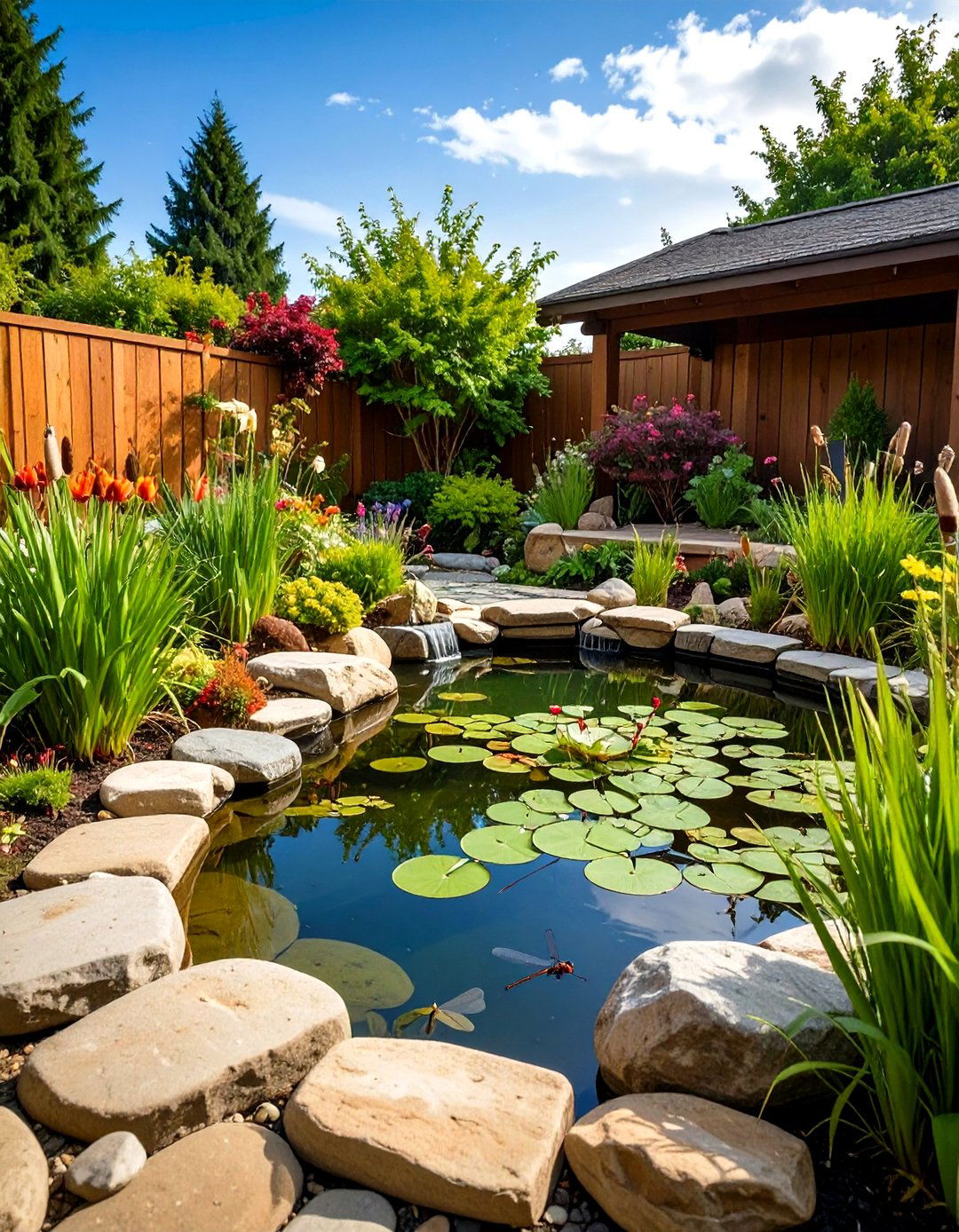
Creating a wildlife-friendly pond transforms your backyard into a thriving ecosystem that supports local biodiversity . Design your pond with gently sloping edges and varied depths to accommodate different species, from visiting birds to beneficial insects. Include shallow margins where amphibians can easily access the water, and consider kidney-shaped designs that provide multiple microhabitats . Native aquatic plants like cattails and water lilies create natural filtration while offering shelter for wildlife. Position rocks and logs around the perimeter to provide basking spots for turtles and frogs. This approach aligns with 2025's emphasis on supporting local wildlife and creating sustainable garden ecosystems . The reward comes in watching your pond become a bustling hub of natural activity, from dragonflies skimming the surface to birds enjoying daily visits.
2. Container Pond Gardens for Small Spaces
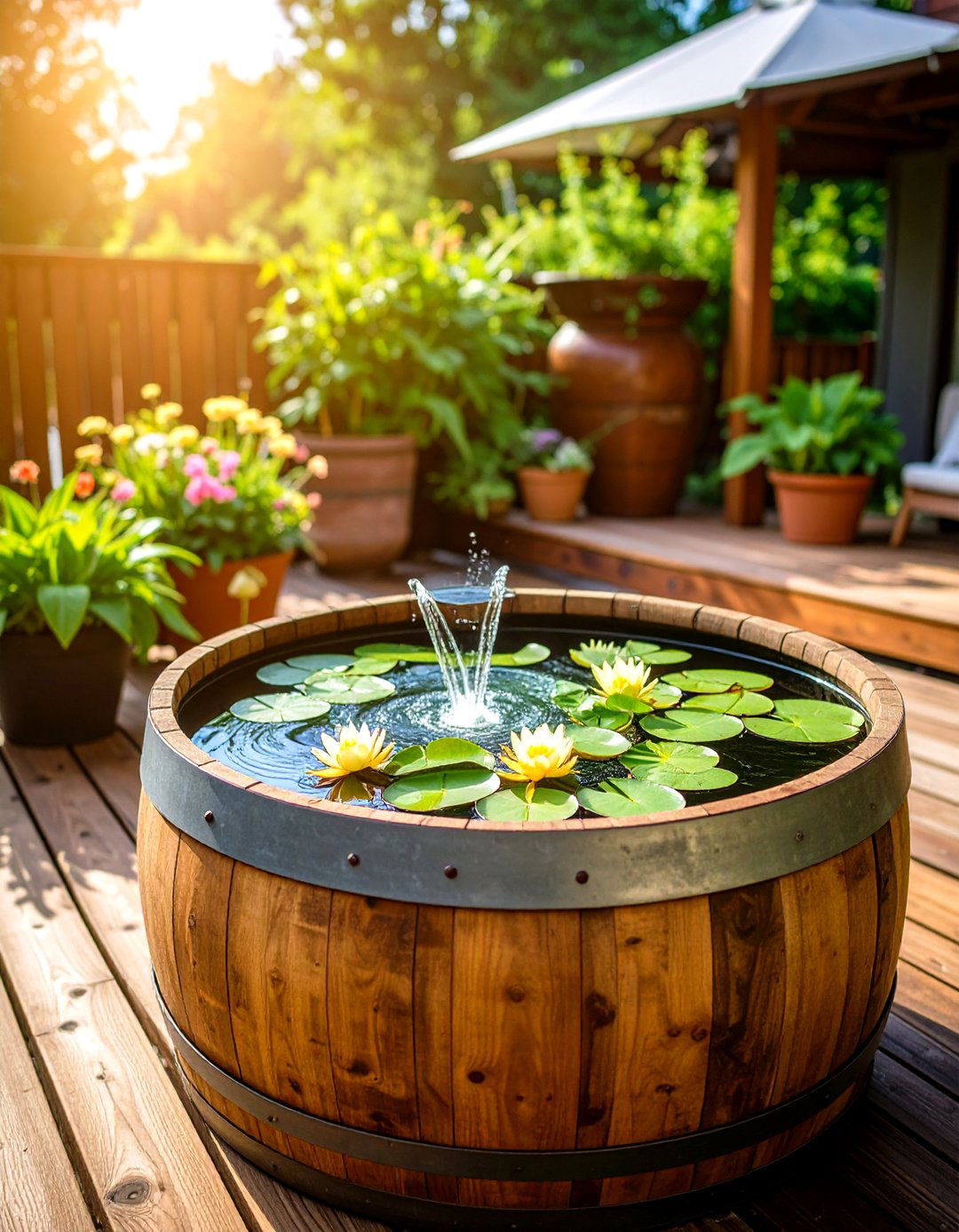
Container ponds offer the perfect solution for patios, decks, and small gardens where traditional ponds aren't feasible . Half whiskey barrels, ceramic pots, or even repurposed galvanized tubs can serve as attractive pond containers . Choose containers at least 24 inches wide and 16 inches deep to accommodate aquatic plants and maintain stable water conditions. Position your container pond in a location receiving 4-6 hours of direct sunlight daily —this sweet spot prevents excessive algae growth while supporting healthy plant development. Add a small solar fountain or pump to keep water circulating and create gentle sounds . These portable water features can be moved seasonally and brought indoors during harsh weather, making them ideal for renters or those who enjoy flexibility in their garden design.
3. Modern Geometric Pond Designs
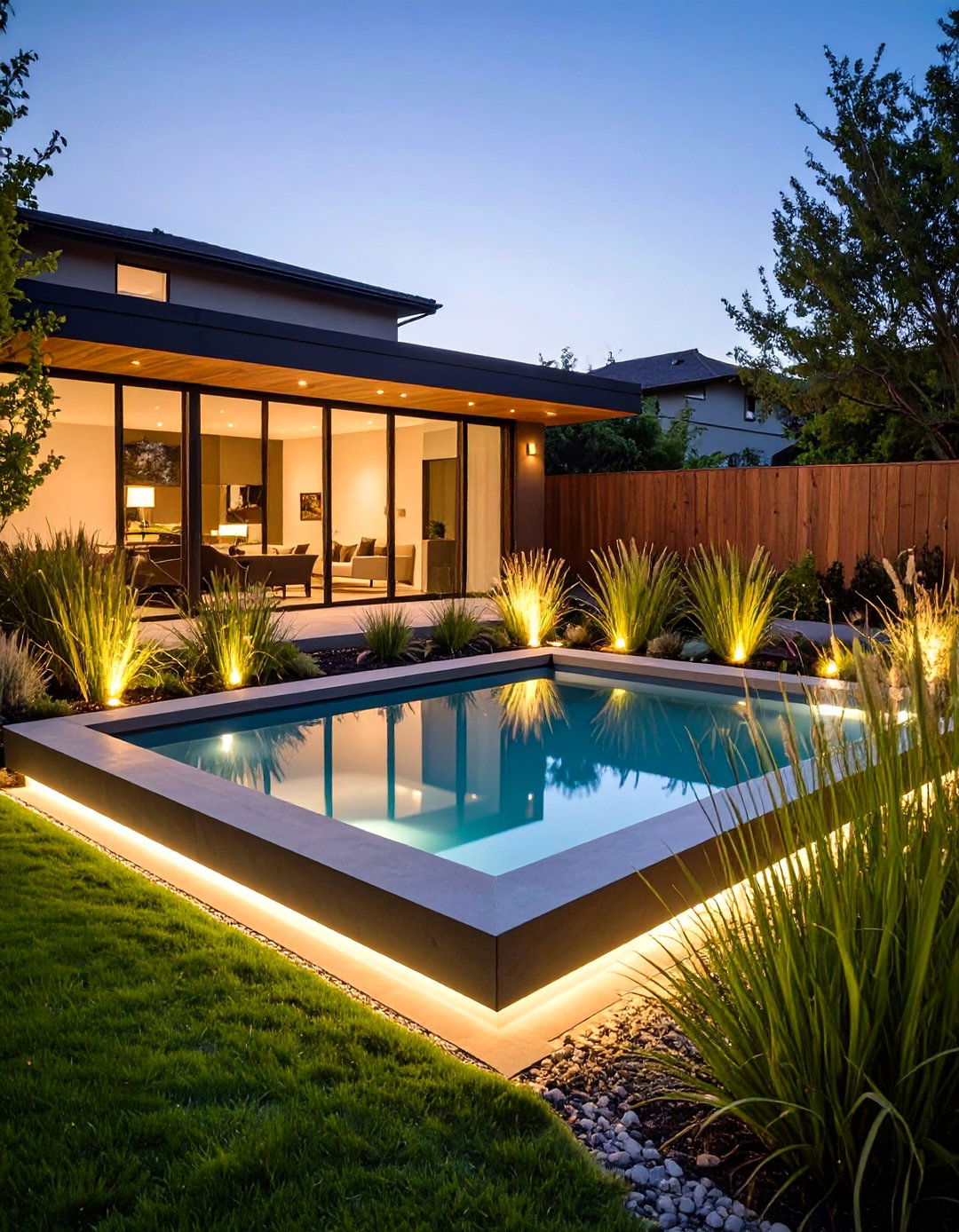
Contemporary pond designs feature clean lines and geometric shapes that complement modern architecture and minimalist landscaping . Rectangular, square, or circular ponds create striking focal points that emphasize order and sophistication. Angular designs work particularly well with contemporary materials like concrete, steel, and glass . Consider incorporating LED strip lighting along the edges to highlight the pond's geometric form during evening hours. Use dark-colored liners or finishes to create a mirror-like surface that reflects surrounding plants and sky . Surround your geometric pond with architectural plants like ornamental grasses or sculptural succulents to enhance the modern aesthetic. These designs require precise construction but offer timeless elegance that increases property value while providing a stunning contrast to softer garden elements.
4. Cascading Waterfall Pond Features
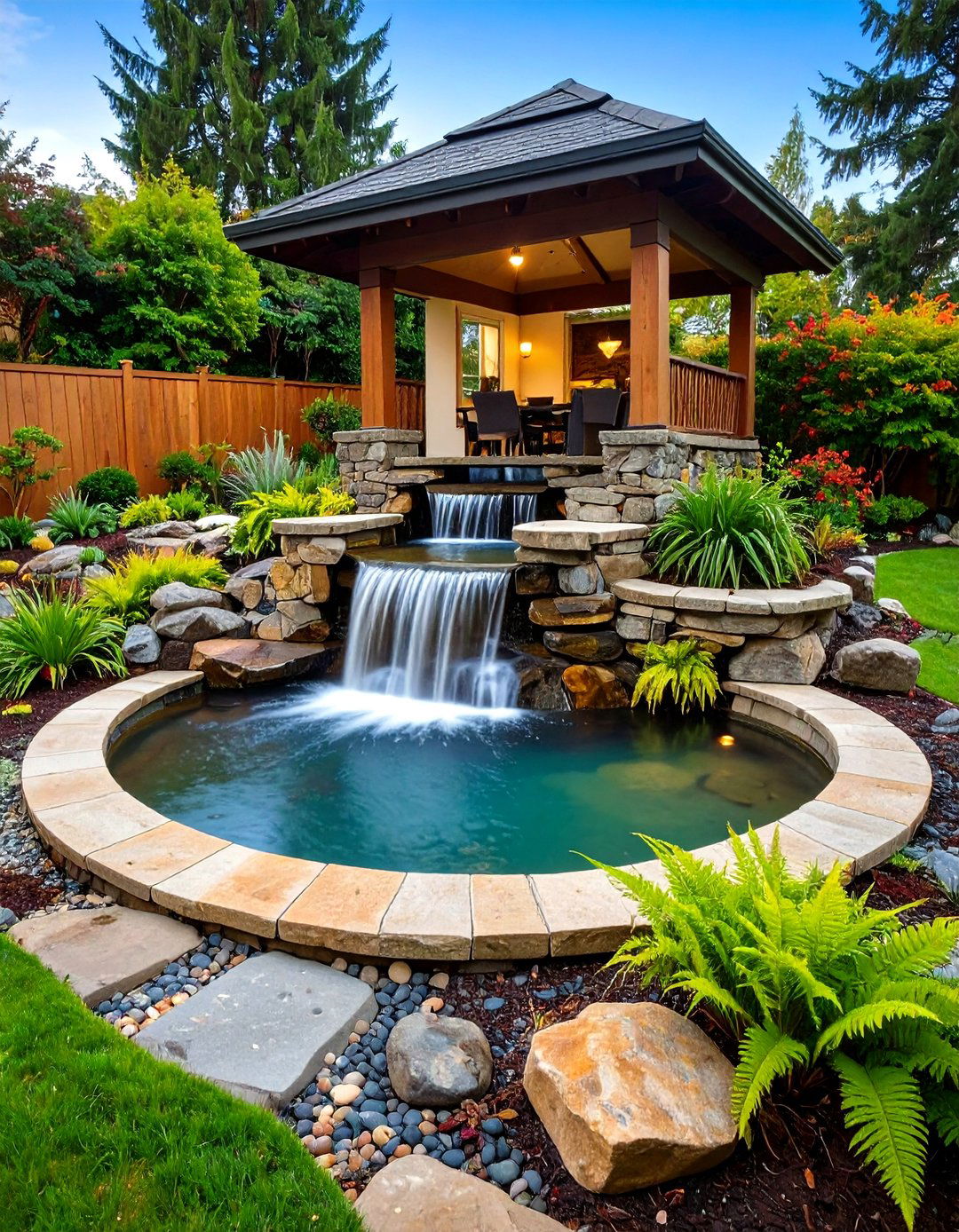
Waterfall ponds create dynamic movement and soothing sounds that transform any backyard into a peaceful retreat . Design multiple levels using natural stone or constructed terraces to create gentle cascades . The sound of flowing water masks neighborhood noise while creating a meditative atmosphere perfect for relaxation. Position larger rocks strategically to create natural-looking water channels and prevent erosion . Consider the scale of your waterfall—gentle trickles work well in intimate settings, while dramatic cascades suit larger landscapes. Install underwater lighting to create magical nighttime displays that highlight the water's movement . Plant ferns and moisture-loving perennials around the waterfall area to create a lush, naturalistic environment. Adding a waterfall feature significantly increases the oxygenation of your pond water , creating healthier conditions for fish and aquatic plants.
5. Koi Pond Designs for Colorful Aquatic Life
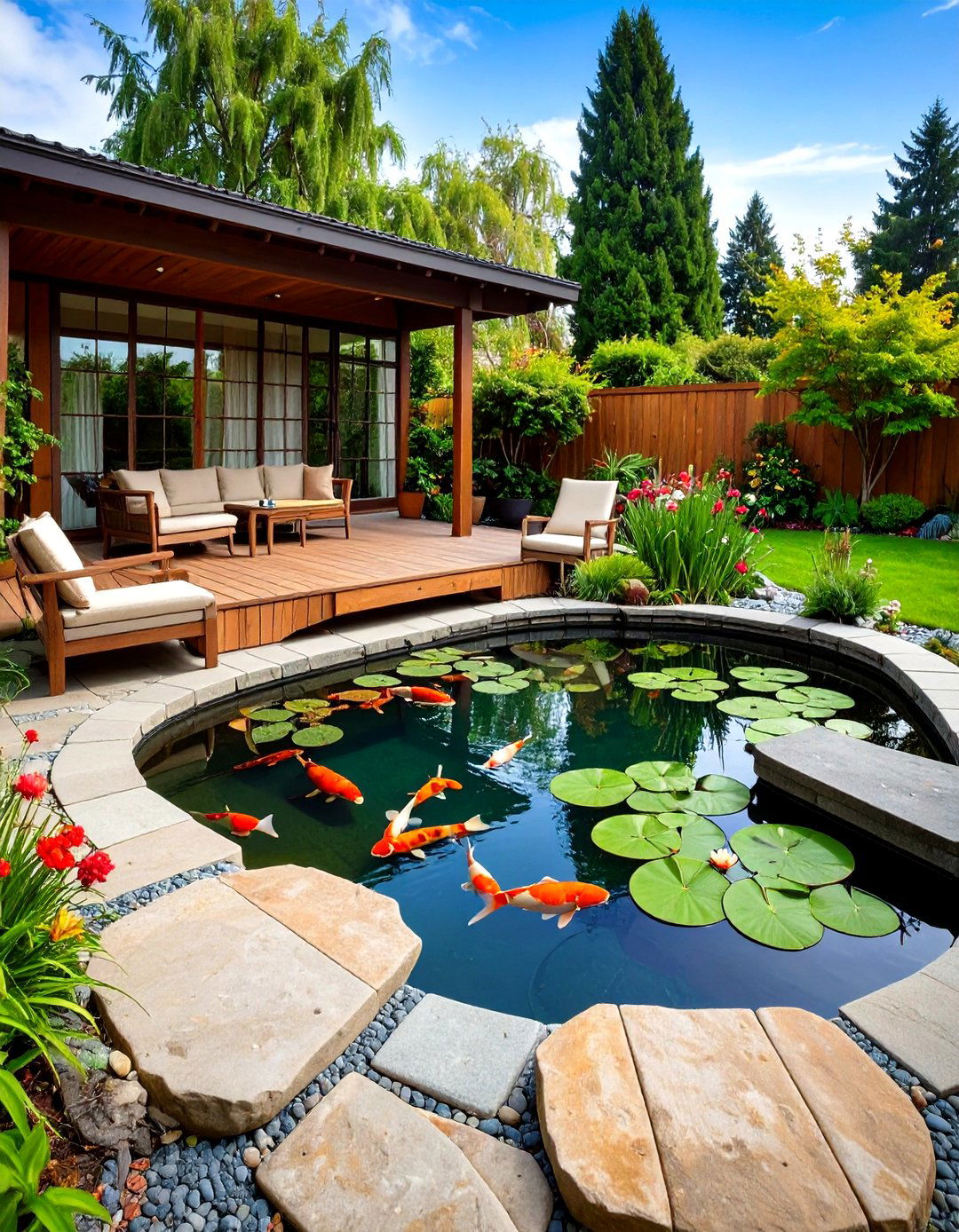
Koi ponds combine the beauty of flowing water with the dynamic interest of colorful fish . Design deeper areas (minimum 3 feet) to provide koi with adequate swimming space and protection from predators . Create viewing areas with comfortable seating positioned at water level to fully appreciate the fish's graceful movements and brilliant colors. Include water lilies and lotus plants in containers to prevent koi from disturbing the roots while providing natural shade . Install proper filtration systems to maintain water quality essential for koi health . Consider adding a bridge or stepping stones across wider sections to create interactive viewing opportunities. Koi ponds require dedicated maintenance but reward owners with years of enjoyment watching these living jewels . The investment in proper construction and filtration pays dividends in creating a stunning centerpiece that brings life and color to your outdoor space.
6. Zen Meditation Pond Gardens
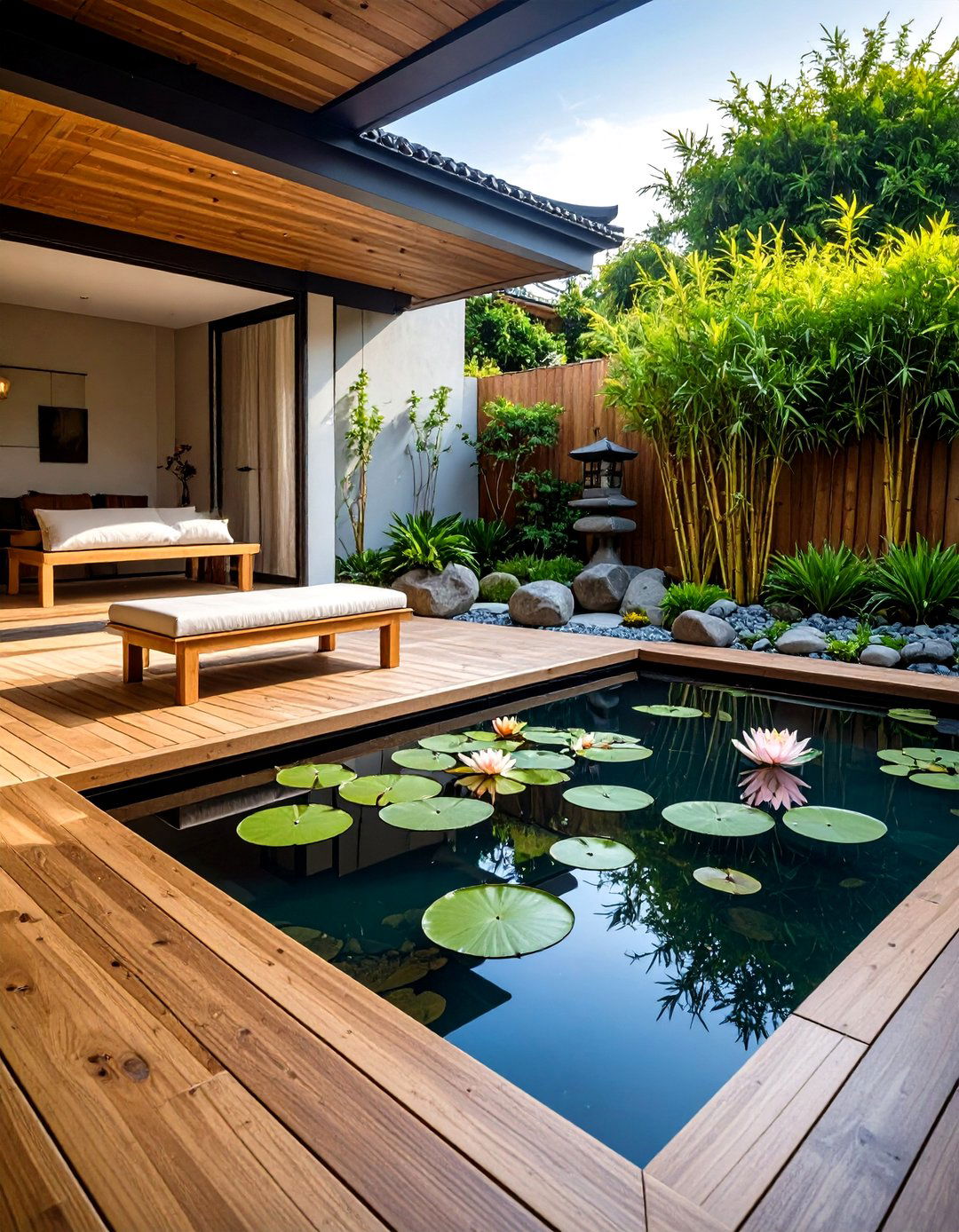
Japanese-inspired pond designs emphasize simplicity and tranquility, creating perfect spaces for meditation and reflection . Use minimal plantings featuring water lilies, bamboo, and carefully positioned stones to achieve serene balance . Still water surfaces act as natural mirrors, reflecting sky and surrounding elements while promoting contemplation . Position single sculptural elements like a stone lantern or simple fountain to serve as focal points without overwhelming the peaceful atmosphere. Choose neutral colors and natural materials that blend harmoniously with the surrounding landscape . Create defined viewing areas with weathered wood benches or flat stones where you can sit quietly and enjoy the pond's calming presence. The key to successful zen pond design lies in restraint—every element should serve a purpose while contributing to the overall sense of harmony .
7. Raised Backyard Ponds for Accessibility
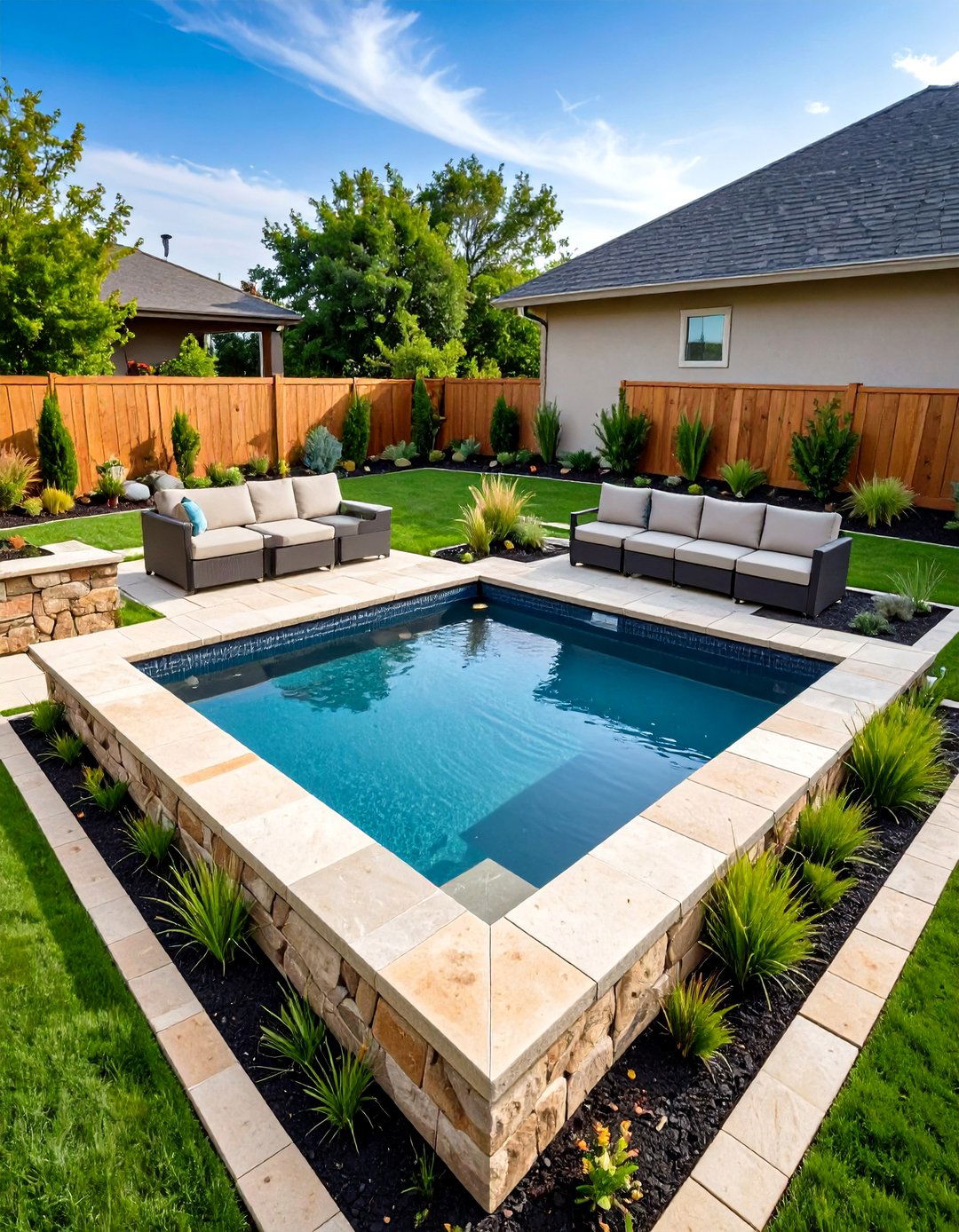
Raised pond designs offer better accessibility and safety while creating dramatic focal points in your landscape . Build raised edges using natural stone, brick, or concrete to create comfortable seating areas around the pond perimeter . This elevation makes maintenance tasks easier and allows better views of aquatic life and plants. Consider raised designs if you have young children or pets, as they provide better control over access to the water . Use retaining walls to create interesting height variations that add architectural interest to flat landscapes. Incorporate built-in planters around raised pond edges to blur the transition between water and garden . These designs work particularly well with formal garden styles and can be integrated with existing hardscaping elements . The elevated position also improves drainage and reduces the risk of runoff contaminating your pond water.
8. Natural Swimming Pond Designs
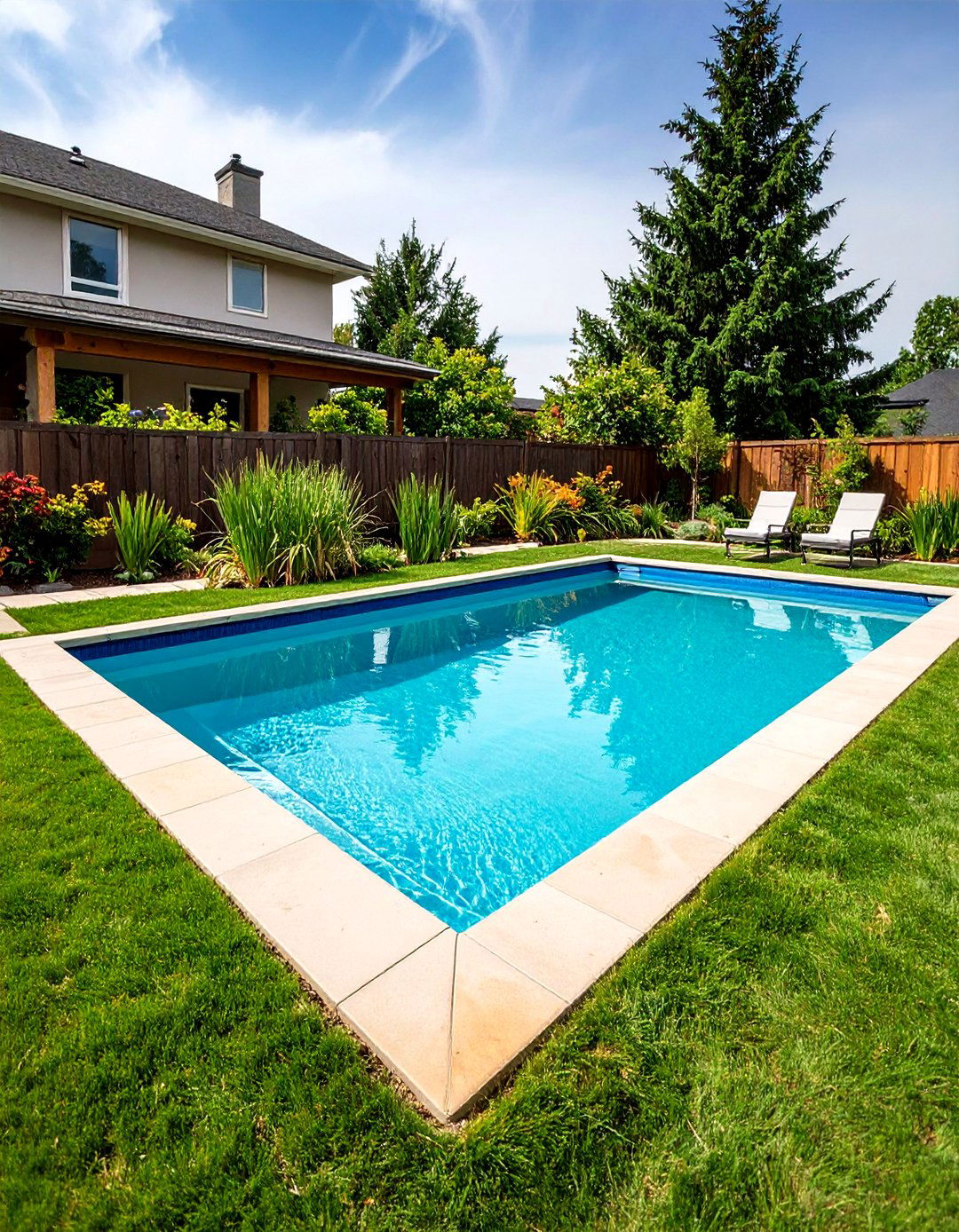
Natural swimming ponds combine recreation with ecological benefits, creating chemical-free swimming environments that blend seamlessly with landscape design . Design separate zones for swimming and natural filtration using aquatic plants that clean the water naturally . Use butyl rubber liners that can be welded together for large-scale installations, ensuring watertight construction . Create graduated depths with shallow regeneration areas planted with emergent vegetation that filters nutrients and maintains water clarity. Consider the site's water table and seasonal variations when planning liner installation . These ponds require larger spaces but offer the ultimate in sustainable recreational water features . Use concrete construction for unlimited design flexibility, allowing custom shapes that complement your landscape . The investment in natural swimming ponds creates a unique backyard destination that provides both relaxation and environmental benefits.
9. Pondless Waterfall Backyard Features
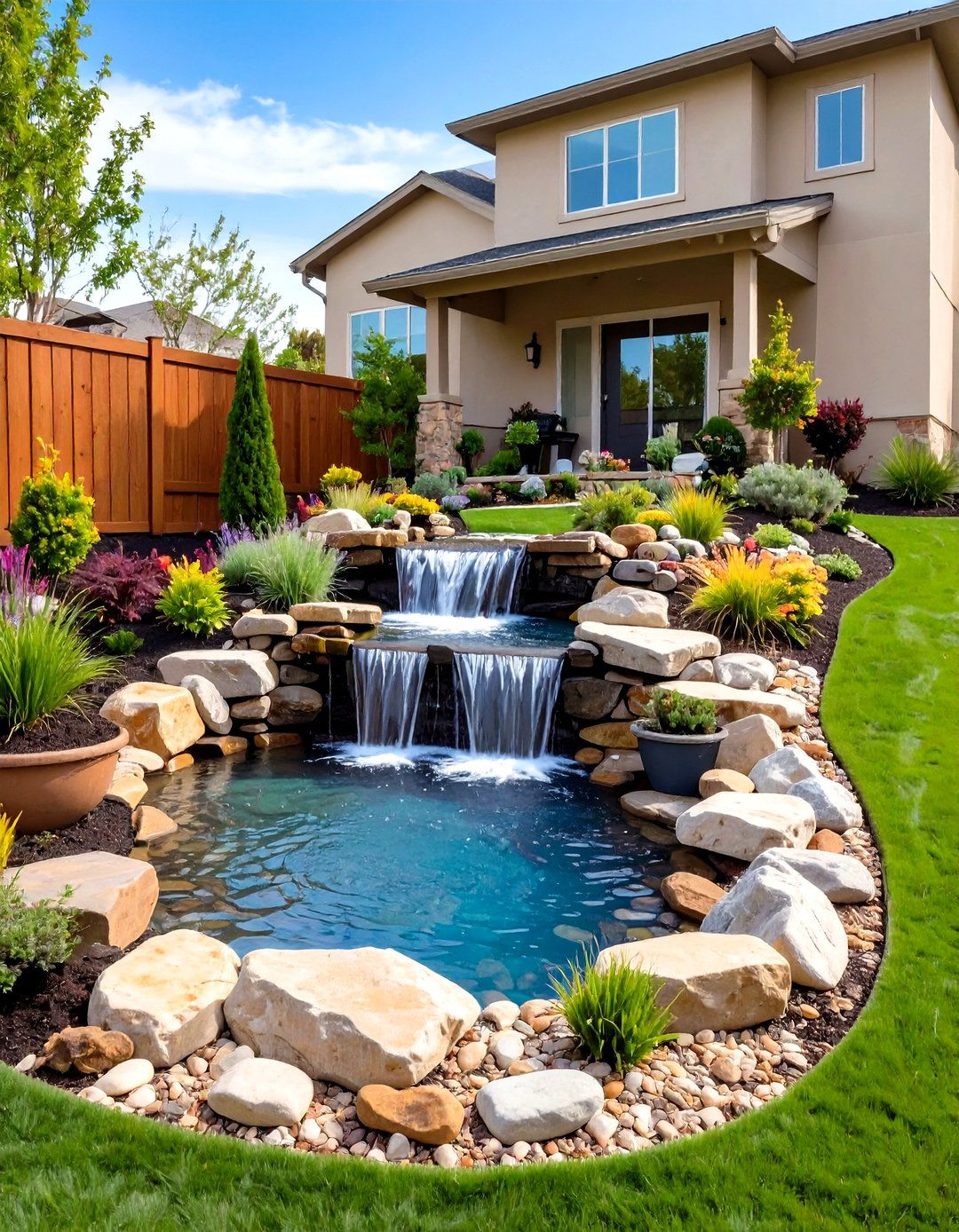
Pondless waterfalls provide the beauty and sound of flowing water without the maintenance requirements of traditional ponds . These low-maintenance features are perfect for families with young children or those who want water's ambiance without pond upkeep . Create the illusion of a natural stream by positioning rocks and boulders to direct water flow through planted areas. Use hidden reservoirs and recirculating pumps to maintain continuous water flow while conserving water . Install these features in slopes or terraced areas to maximize the visual and auditory impact . Plant moisture-loving perennials and ferns around the water course to create lush, natural-looking landscapes. Pondless waterfalls fit into small spaces and can be incorporated into existing garden beds . The combination of moving water and strategic plantings creates cooling microclimates that benefit both plants and people during hot weather.
10. Mirror Reflection Pond Designs
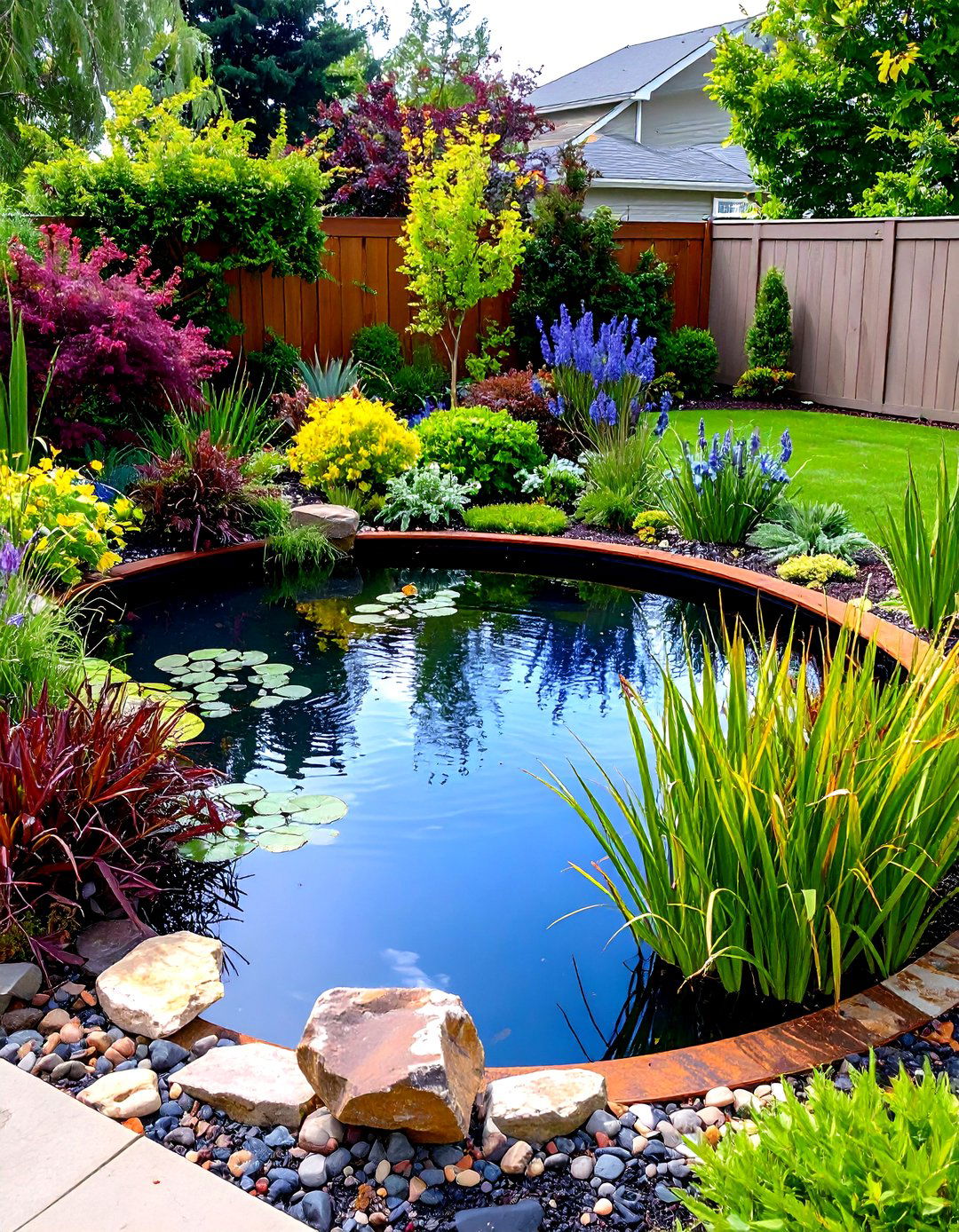
Reflection ponds create stunning visual effects by capturing and displaying sky, clouds, and surrounding landscape elements . Position these ponds where they can be viewed from key areas of your home and garden to maximize their impact throughout the year . Keep water surfaces still by minimizing plant coverage and avoiding water circulation features . Use dark-colored finishes on pond bottoms to enhance the mirror effect and create greater depth perception . Consider raised designs using materials like corten steel or zinc for contemporary installations . Design surrounding areas with sculptural plants and architectural elements that will create interesting reflections. These ponds require less maintenance than planted water features but demand attention to design details . The result is a sophisticated water feature that changes appearance throughout the day as light conditions shift, providing endless visual interest.
11. Container Pond Fish Habitats
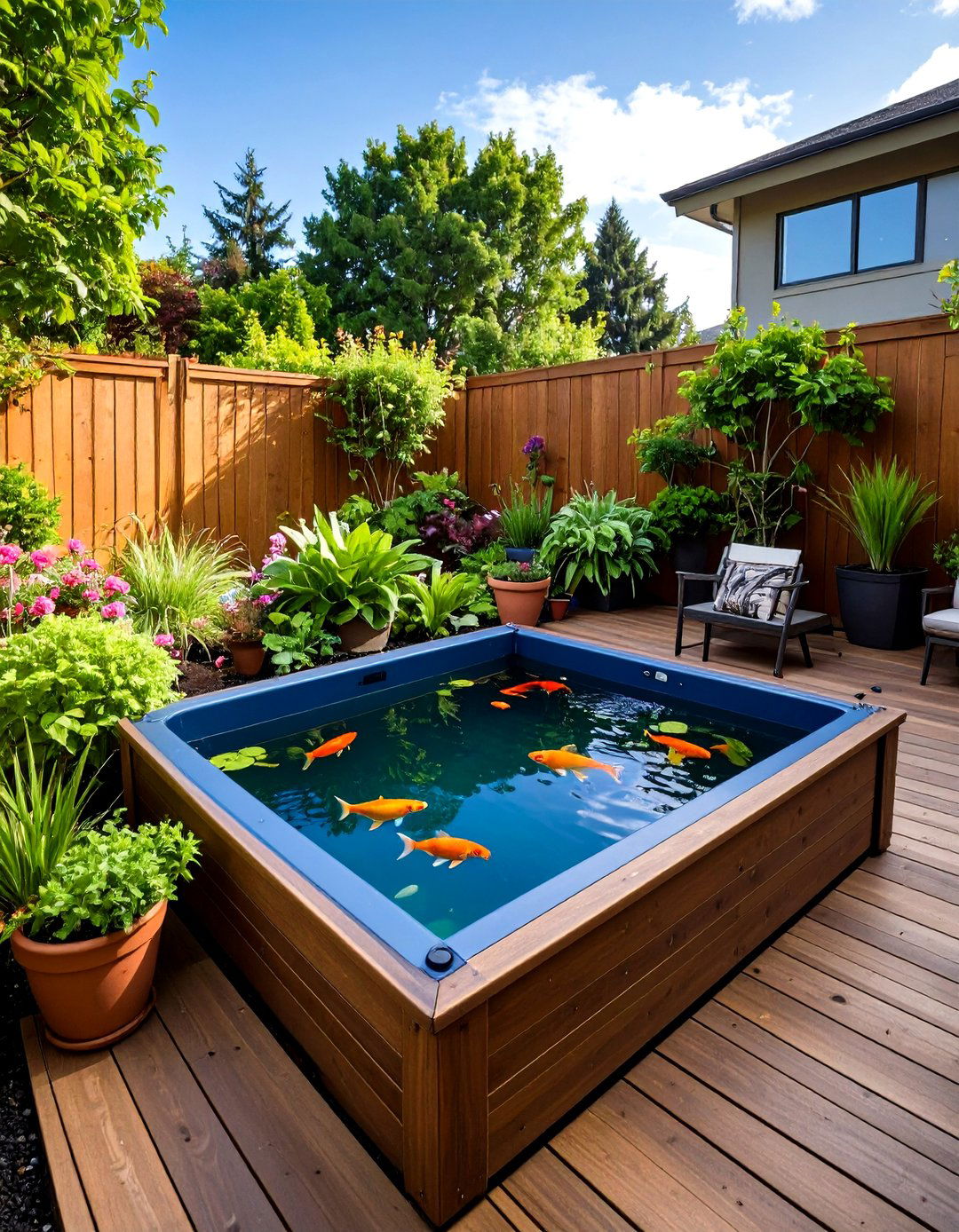
Small pond containers can successfully house colorful fish while creating dynamic water features on patios and decks . Choose fish species appropriate for container environments, such as goldfish or "rosy reds" that help control algae and mosquito larvae . Ensure containers hold at least 20 gallons of water to provide adequate space for fish to thrive . Add oxygenating plants and consider small filtration systems to maintain water quality . Use de-chlorinated water and avoid over-fertilizing plants, as excess nutrients can harm fish . In cold climates, plan for winter protection by moving containers to protected areas or bringing fish indoors . Monitor water temperature and provide shade during hot weather to prevent stress on fish . These living water features bring incredible joy as fish personalities emerge and their graceful movements add constant interest to outdoor spaces.
12. Multi-Level Terraced Pond Systems
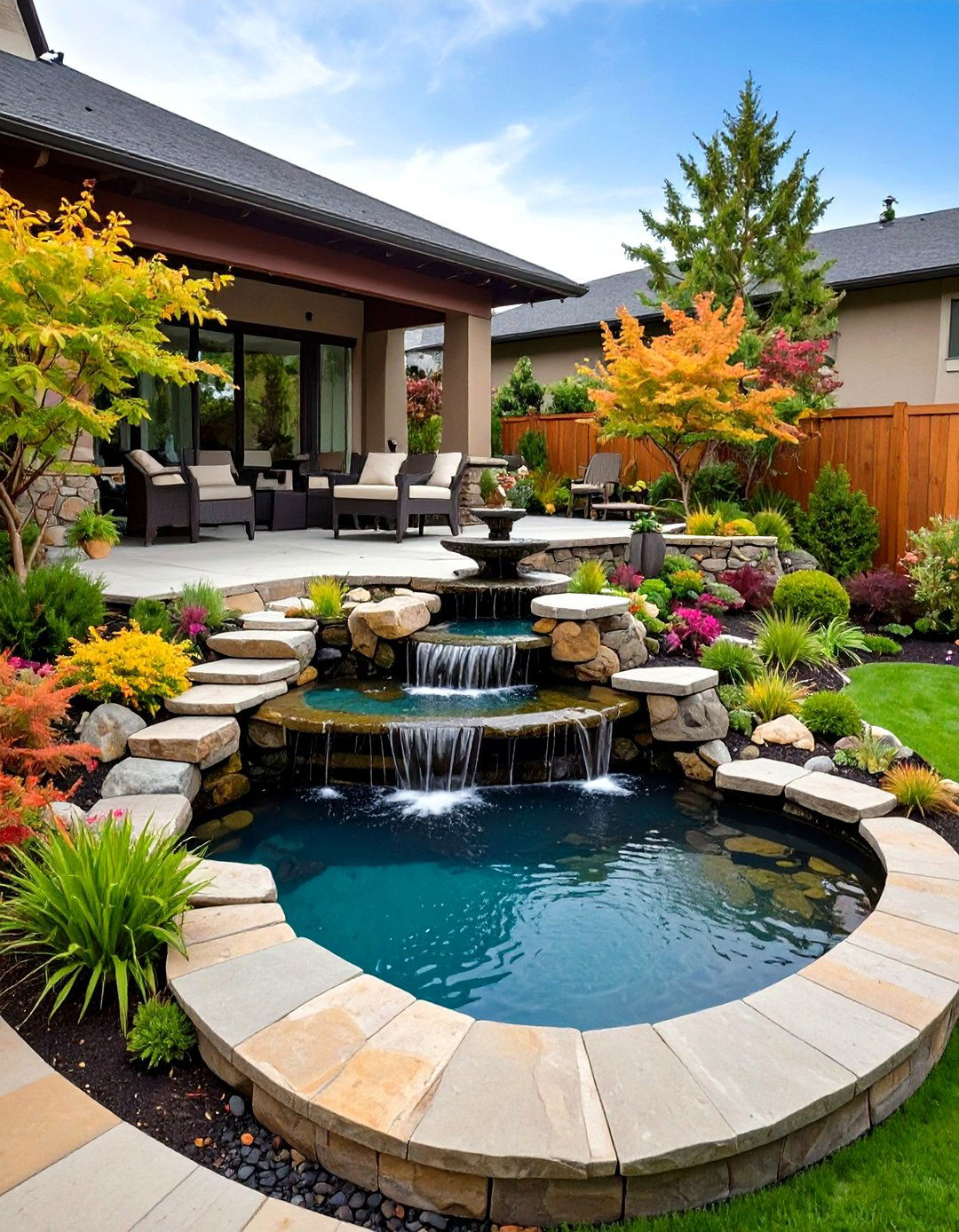
Terraced pond designs create dramatic focal points while maximizing water feature impact in sloped landscapes . Use natural grade changes to create multiple water levels connected by streams or small waterfalls . Build retaining walls using natural stone to create stable terraces that blend with the landscape . Each level can serve different purposes—upper ponds for dramatic effect, middle levels for aquatic plants, and lower areas for fish habitat. Create comfortable viewing areas at different elevations to appreciate the entire system . Design varying depths within each terrace to accommodate different aquatic plants and create diverse microhabitats . Use proper liner installation techniques to ensure watertight connections between levels . These complex systems require careful planning but create stunning backyard destinations that provide multiple perspectives and experiences .
13. Seasonal Pond Gardens with Year-Round Interest
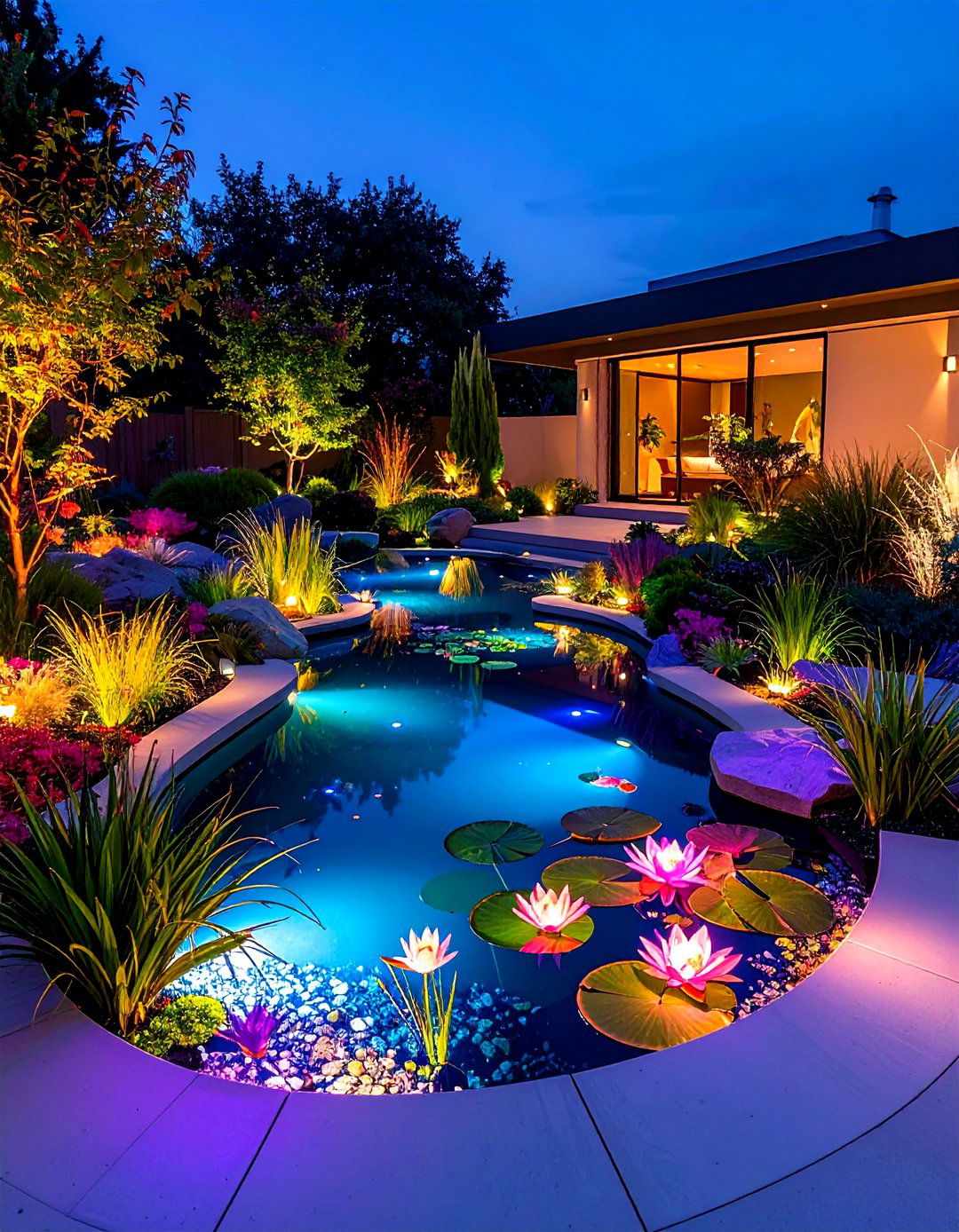
Design pond gardens that provide visual interest throughout all seasons by incorporating plants with varying bloom times and foliage characteristics . Spring is the ideal time to establish pond plantings, allowing plants to develop strong root systems before summer heat. Choose a mixture of emergent plants, floating species, and submerged oxygenators to create diverse textures and colors. Add winter interest with ornamental grasses and evergreen plants positioned around pond margins . Plan for cold weather protection of sensitive plants and consider heating elements for fish survival . Use hardy, perennial aquatic plants to avoid annual replanting and ensure consistent appearance . Incorporate underwater lighting to maintain pond visibility and beauty during shorter winter days . This approach aligns with sustainable gardening practices while providing continuous enjoyment of your water feature .
14. Backyard Pond Lighting for Evening Ambiance
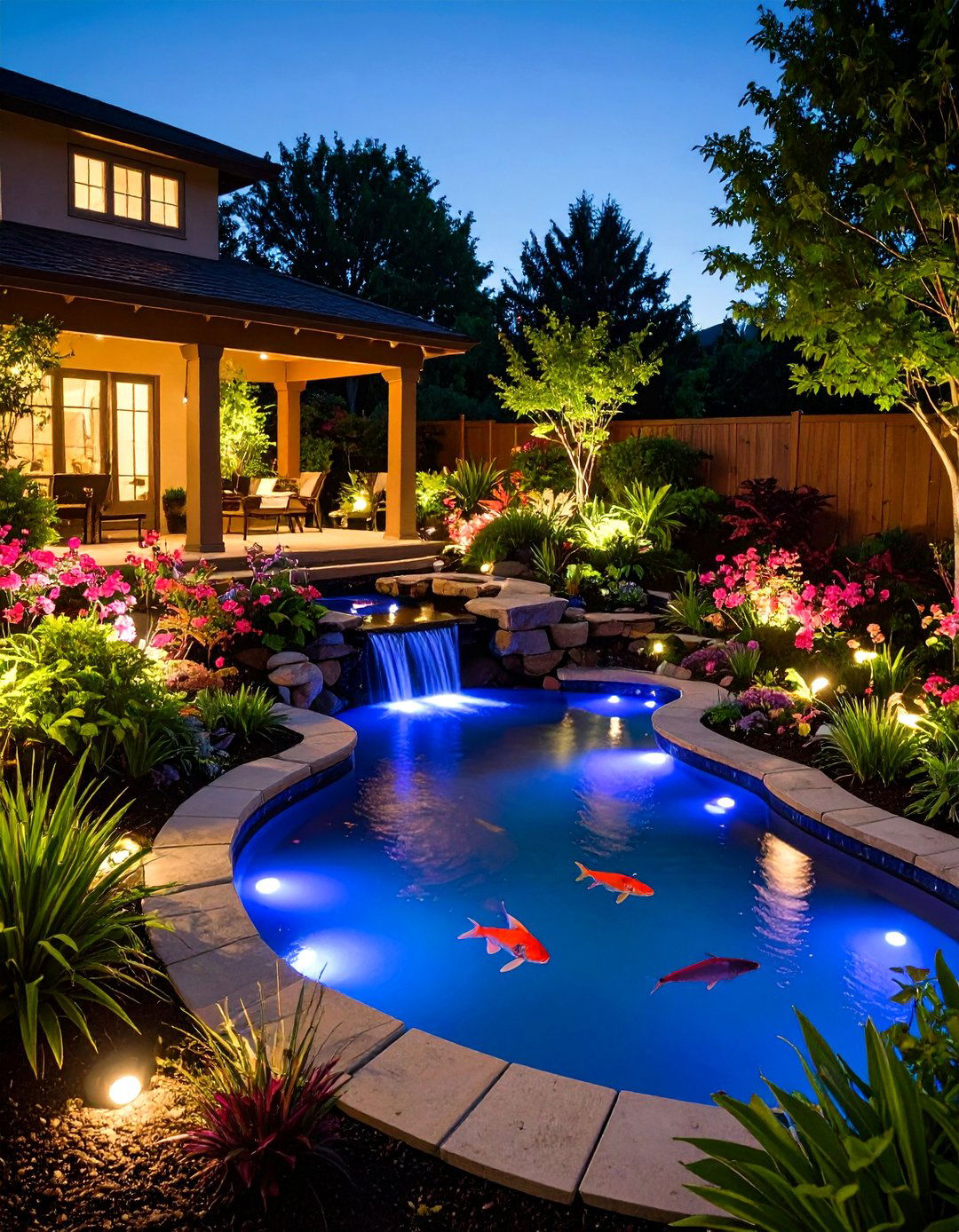
Strategic lighting transforms pond features into magical nighttime focal points that extend outdoor enjoyment well into evening hours . Install waterproof LED lights beneath waterfalls and around pond perimeters to highlight water movement and create dramatic effects . Use underwater spotlights to illuminate fish and aquatic plants, creating enchanting displays that showcase pond life . Consider color-changing LED systems that allow you to adjust lighting moods for different occasions and seasons. Ensure all electrical installations include GFCI protection and use weatherproof connections designed for outdoor water features . Combine uplighting with pathway lighting to create safe navigation around pond areas while maintaining ambiance . Position lights to avoid glare while highlighting key features like bridges, sculptures, or particularly attractive plantings . Energy-efficient LED systems provide long-lasting illumination with minimal power consumption .
15. Natural Stone Pond Edging and Hardscaping
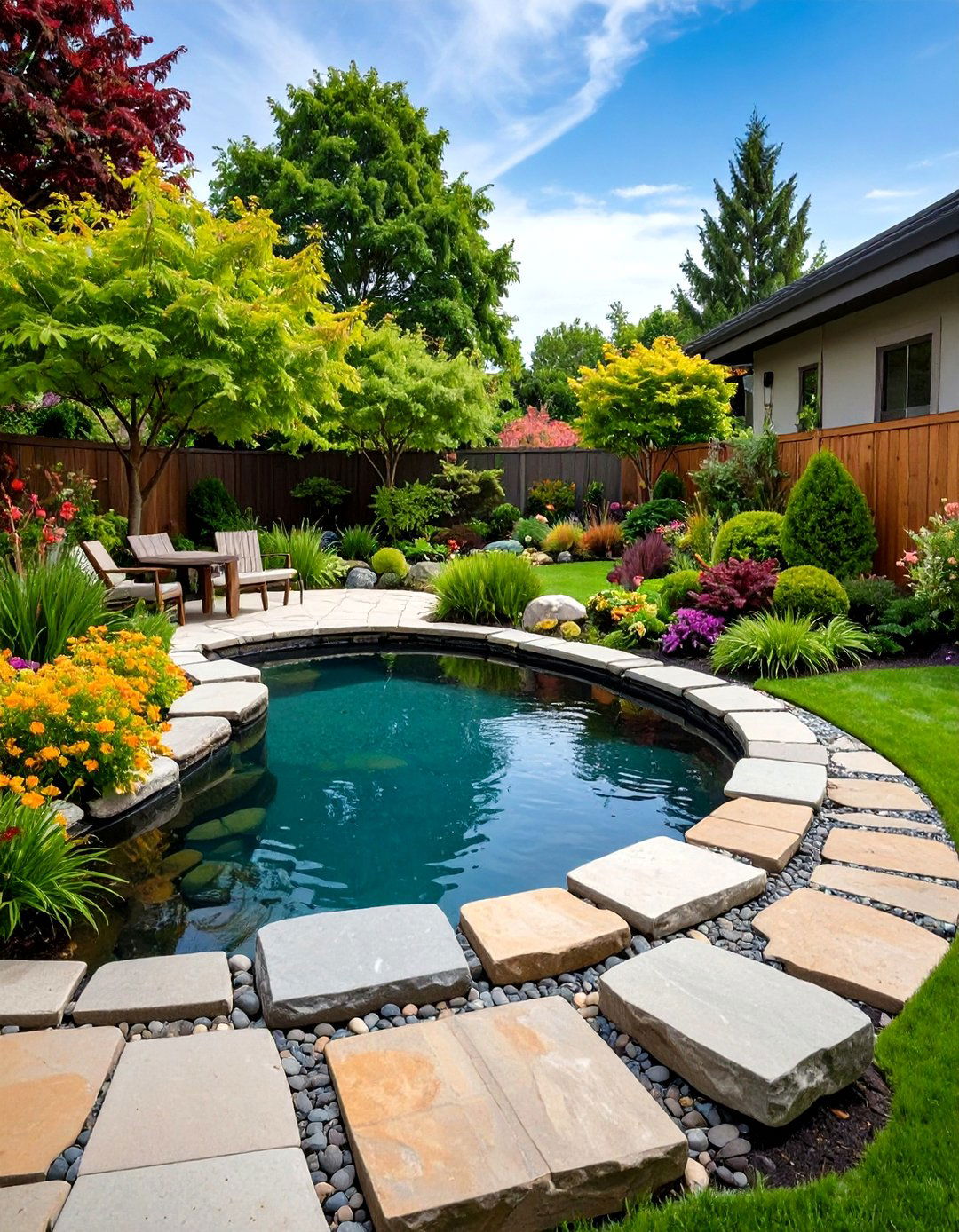
Natural stone edging creates seamless transitions between water features and surrounding landscapes while providing durable, attractive borders . Mix different stone sizes and shapes to create natural-looking edges that appear to have formed organically . Choose materials like granite, sandstone, or local fieldstone that complement your region's natural geology . Allow some stones to extend into the water to create basking spots for wildlife and interesting visual textures . Use flat stones to create informal seating areas where you can sit close to the water's edge . Install stepping stones across wider pond sections to create interactive walkways that connect different garden areas . Ensure stone edging is properly supported and stable to prevent shifting and maintain safety . Natural stone provides long-lasting beauty that weathers gracefully while supporting the pond's structural integrity .
16. Bog Garden Pond Extensions
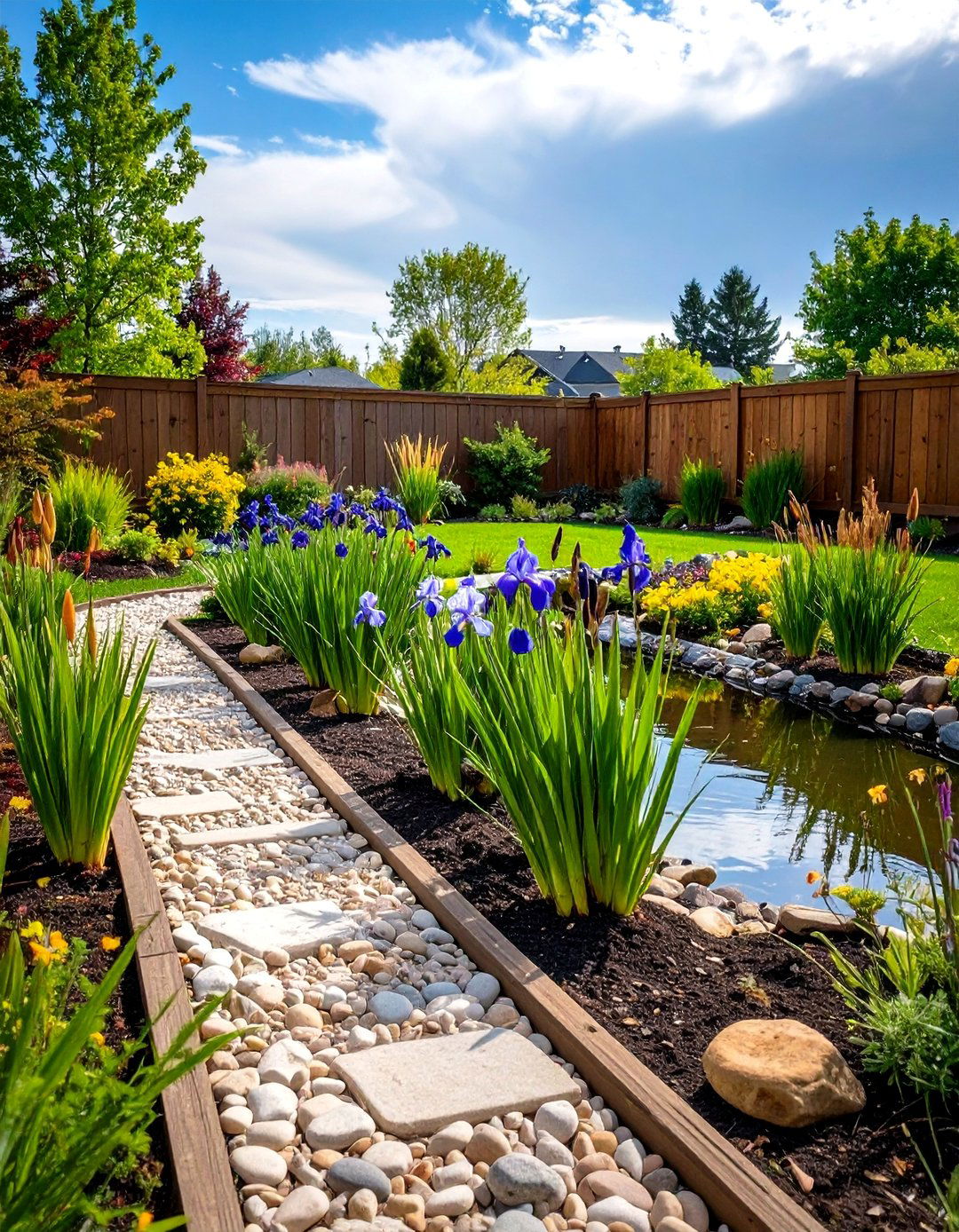
Bog gardens adjacent to ponds create expanded habitats for moisture-loving plants while providing natural filtration for pond water . Design bog areas with consistently moist soil that drains slowly, mimicking natural wetland conditions . Use pond liner extensions covered with gravel and soil to create these specialized planting areas . Plant native wetland species that provide food and shelter for wildlife while creating diverse microhabitats . Include marginal plants like cattails, iris, and sedges that thrive in consistently moist conditions . Bog gardens help balance pond ecosystems by processing nutrients and providing breeding areas for beneficial insects . These extensions require minimal maintenance once established and provide year-round interest with seasonal color changes . Bog gardens align with current trends toward native plantings and sustainable landscape design .
17. Backyard Pond Bridges and Walkways
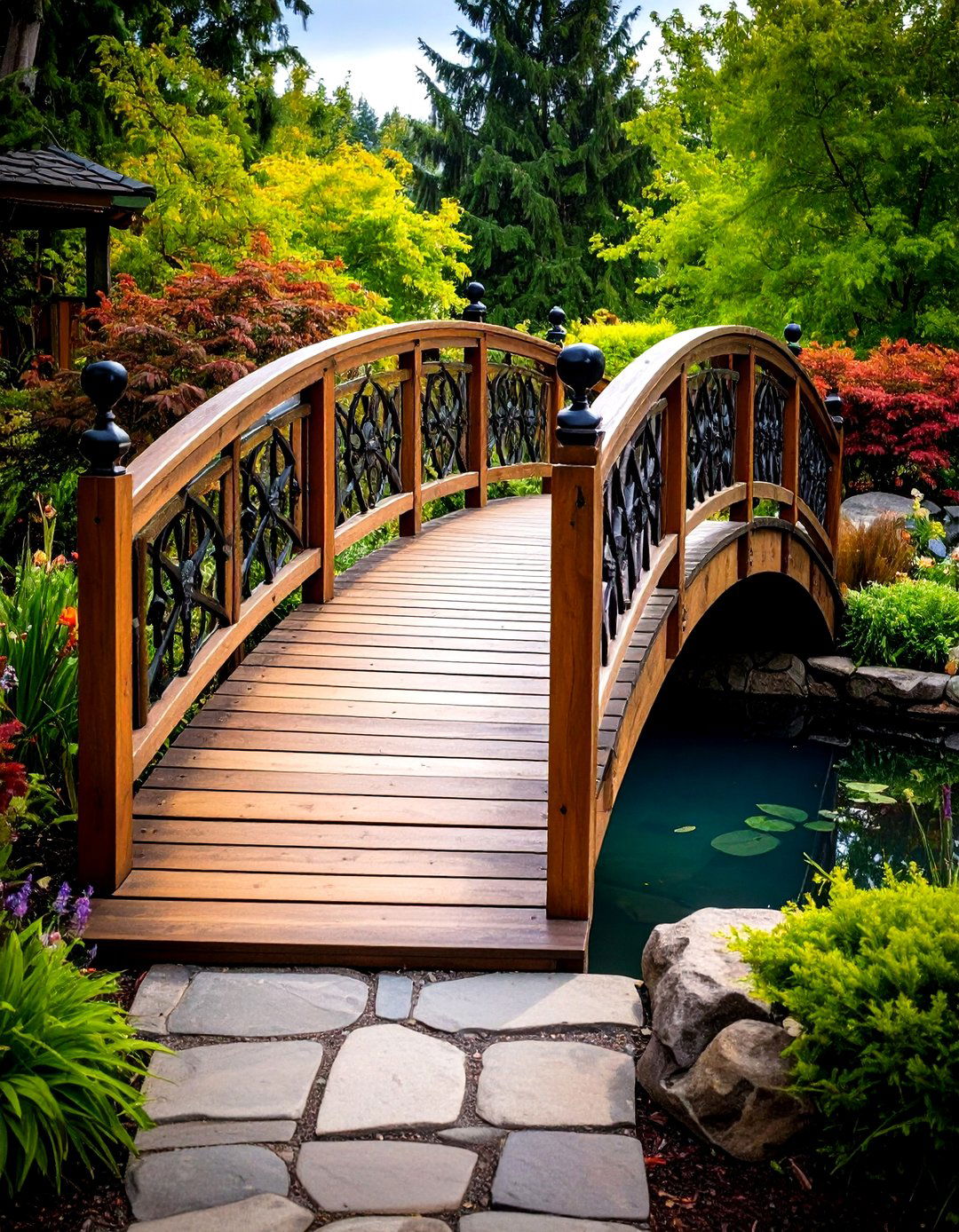
Pond bridges add functional beauty while creating intimate connections between different garden areas . Design bridges that enhance pond functionality while requiring minimal maintenance once installed . Use materials like treated wood, natural stone, or metal that can withstand moisture and seasonal weather changes . Ensure bridges are sufficiently wide and stable for safe passage while standing clear of water surfaces . Consider arched designs that provide adequate clearance for aquatic plants while creating elegant focal points. Position bridges at natural crossing points or where they frame attractive pond views . Add railings if bridges are elevated or if safety is a concern, using materials that complement the overall design . Bridges transform ponds from simple water features into interactive landscape elements that invite exploration and provide unique perspectives .
18. Aquatic Plant Combination Pond Gardens
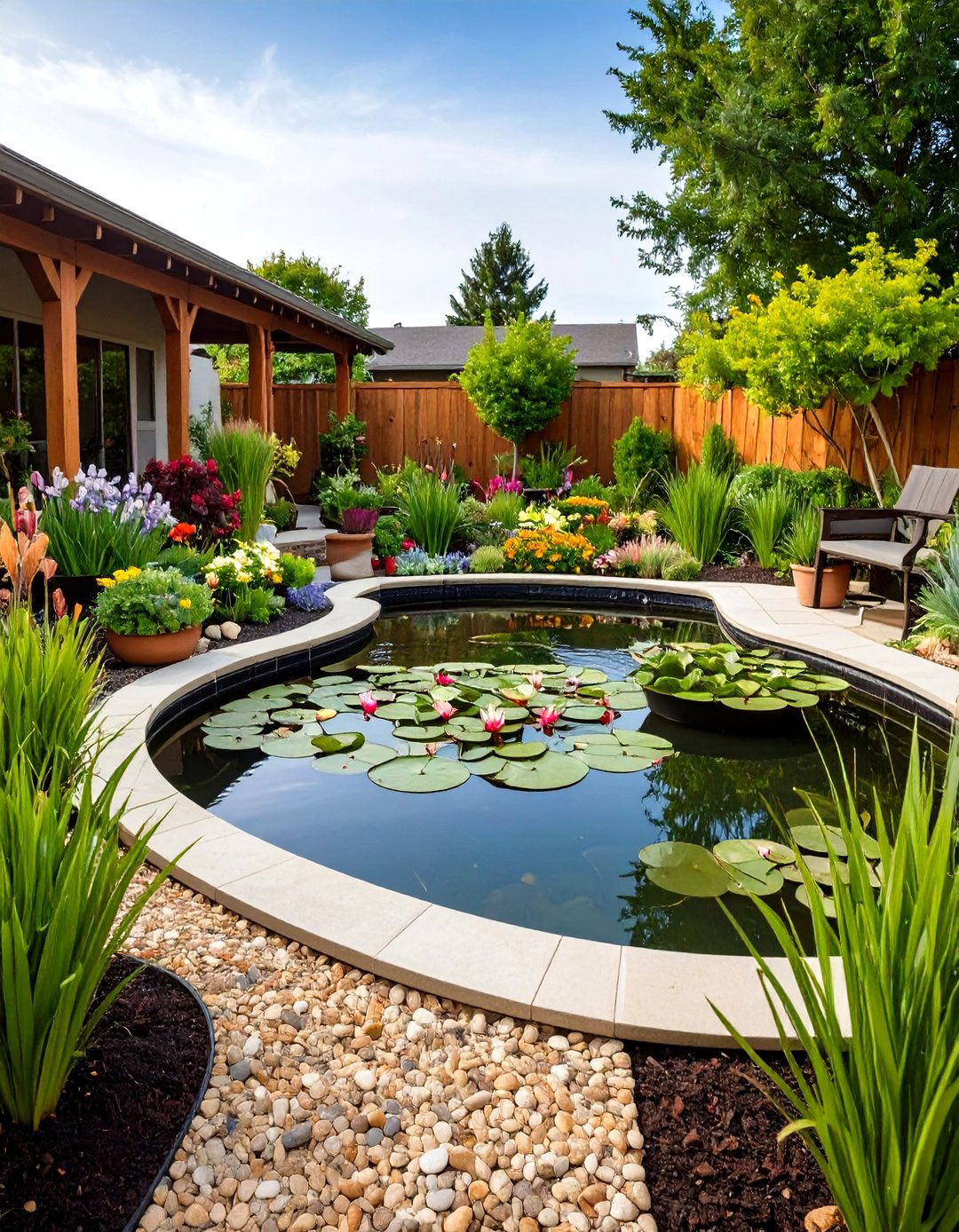
Successful pond gardens combine different types of aquatic plants to create balanced ecosystems and year-round visual interest . Include floating plants like water lettuce and lotus, submerged oxygenators, and emergent marginal species . Choose plants with contrasting shapes, colors, and textures to create dynamic compositions that change throughout the growing season . Select three to four plant species for smaller ponds (10-15 gallons) and up to six species for larger features . Use aquatic planting baskets filled with specialized compost and topped with pea gravel to contain plant roots . Combine tall, spiky plants like iris with broad-leafed species like taro for maximum visual impact . Choose hardy perennial species to avoid annual replanting and ensure consistent pond appearance . Proper plant selection creates natural water filtration while providing habitat for beneficial wildlife .
19. DIY Budget-Friendly Pond Projects

Budget-conscious pond projects can create stunning water features using repurposed materials and simple construction techniques . Transform plastic kiddie pools, old bathtubs, or galvanized tubs into functional pond containers . Repurpose fire pits, washing bowls, or large plant containers to create wildlife-friendly habitat ponds . Use heavy black plastic as liner material for simple installations, ensuring proper protection with underlayment . Seal drainage holes with silicone and add ramps using bricks or stones for wildlife access . Surround budget ponds with inexpensive perennials and native plants to create attractive integrated landscapes . Focus on function over elaborate design, creating habitats that provide water, food, and shelter for local wildlife . These projects prove that beautiful, functional pond features are achievable regardless of budget constraints .
20. Maintenance-Free Pond Design Strategies
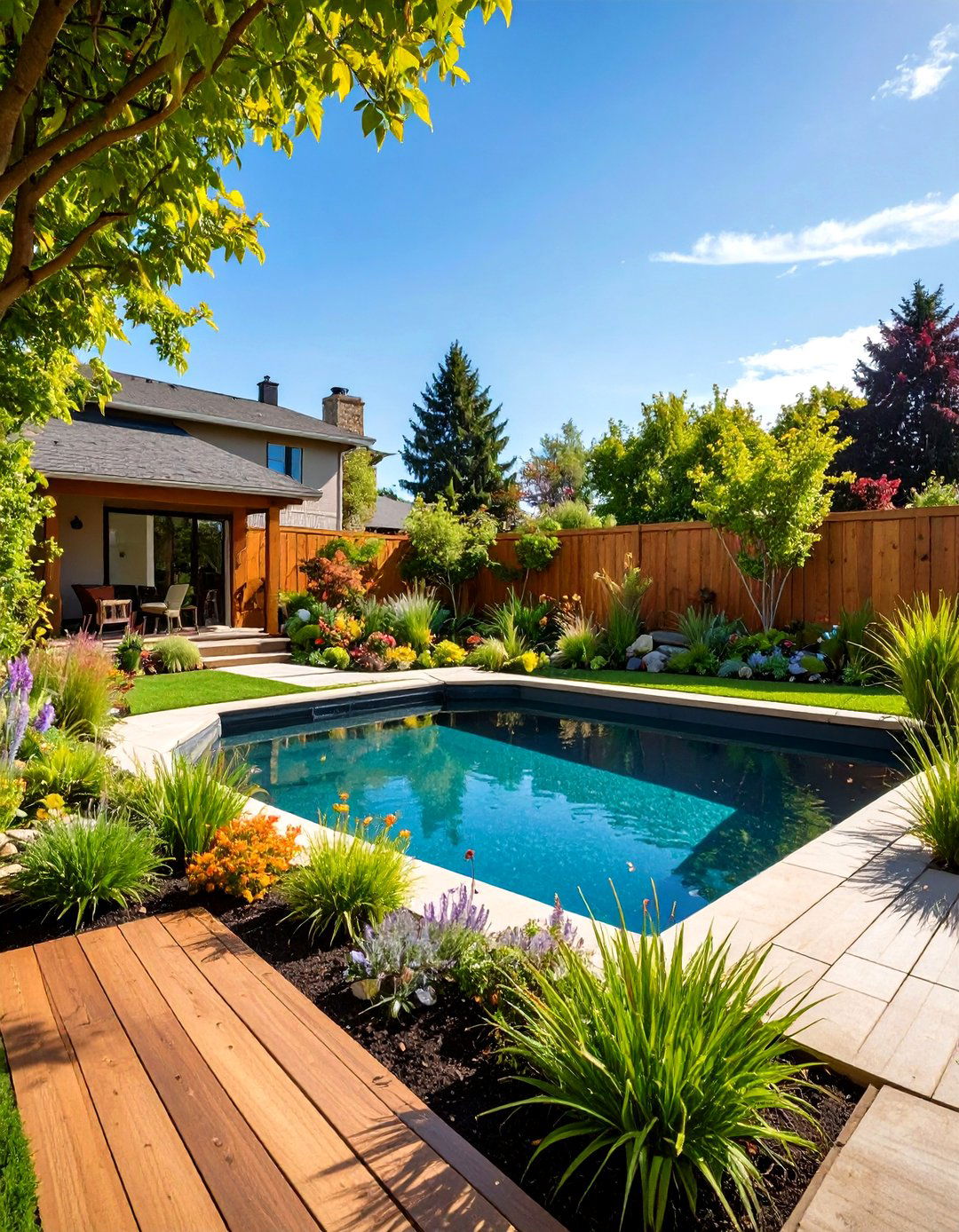
Design pond features that minimize maintenance requirements while maximizing enjoyment and ecological benefits . Choose hardy, perennial aquatic plants that require minimal care once established . Install proper filtration systems and oxygenating plants to maintain water quality naturally . Use pondless waterfall designs that provide water feature benefits without the upkeep of traditional ponds . Allow natural processes to balance pond ecosystems rather than relying on chemical treatments . Position ponds to receive optimal sunlight (4-6 hours daily) while avoiding excessive heat that promotes algae growth . Use rainwater to fill and top off ponds, avoiding tap water's excess nutrients that encourage algae. Select appropriate fish species and avoid overcrowding to maintain healthy water conditions . Focus on sustainable design principles that work with natural processes rather than against them .
Conclusion:
Creating your dream backyard pond opens doors to endless possibilities for enhancing your outdoor living space while supporting local ecosystems. From simple container gardens perfect for small patios to elaborate multi-level water features that transform entire landscapes, there's a pond design suited to every space, budget, and maintenance preference. Current trends emphasize sustainable practices, native plantings, and wildlife-friendly features that create thriving habitats while reducing environmental impact . Whether you choose a modern geometric design that complements contemporary architecture or a natural wildlife pond that attracts local fauna, your water feature will become a source of daily joy and tranquility. The key to success lies in matching your pond design to your specific site conditions, maintenance capabilities, and personal aesthetic preferences . Start with a clear vision, plan carefully, and remember that even the smallest water feature can transform your backyard into a peaceful retreat that provides years of enjoyment for you, your family, and the wildlife you choose to welcome.


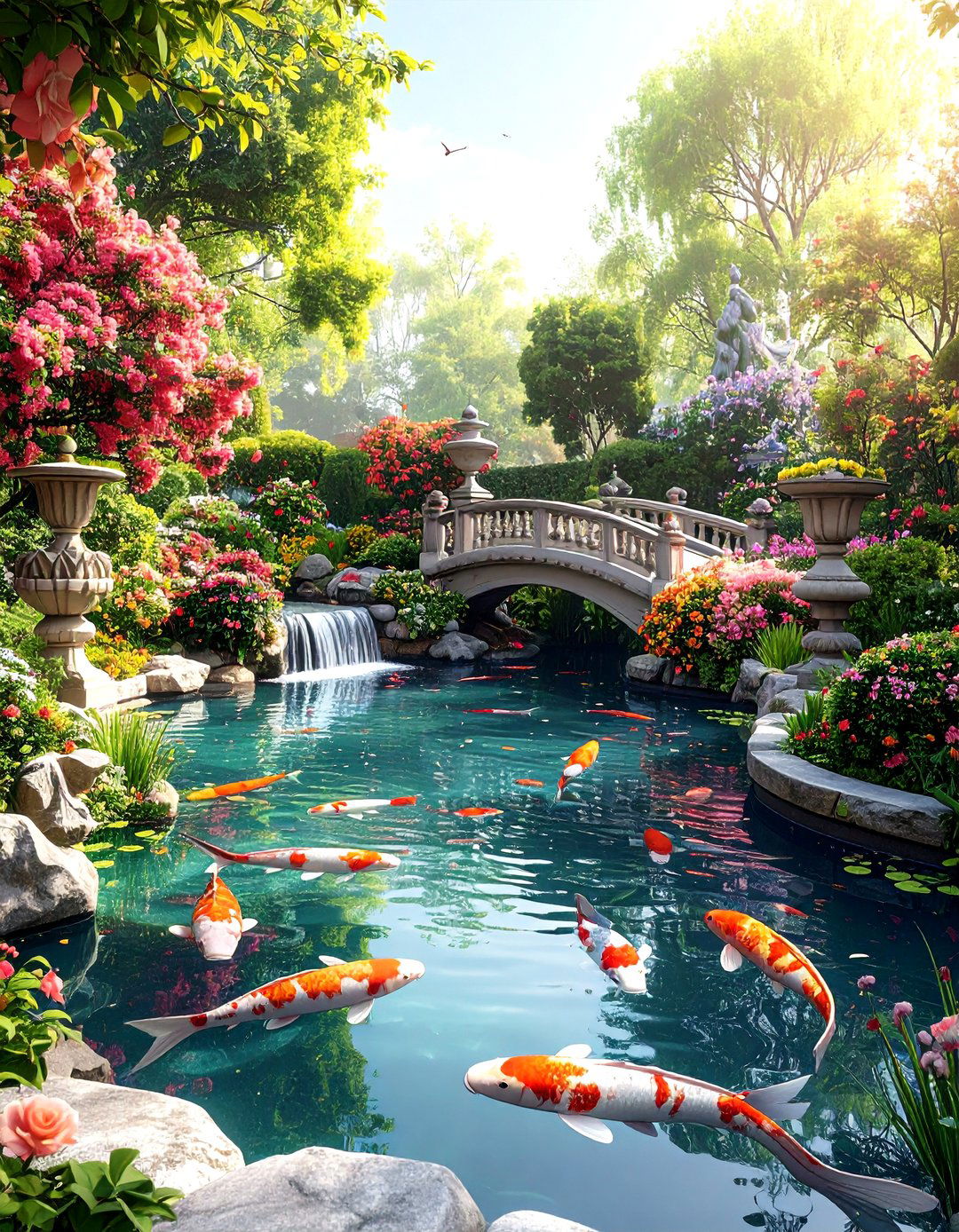

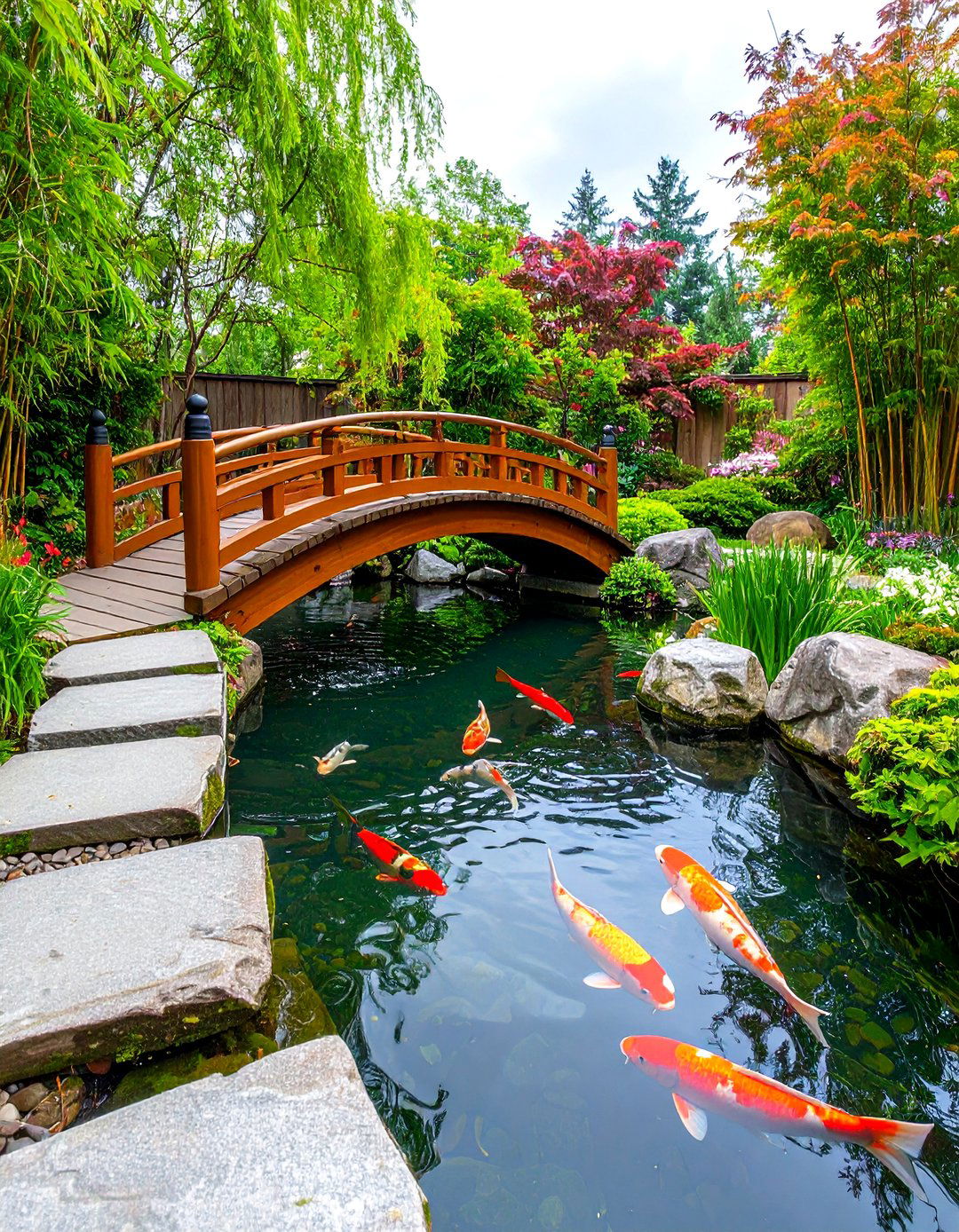
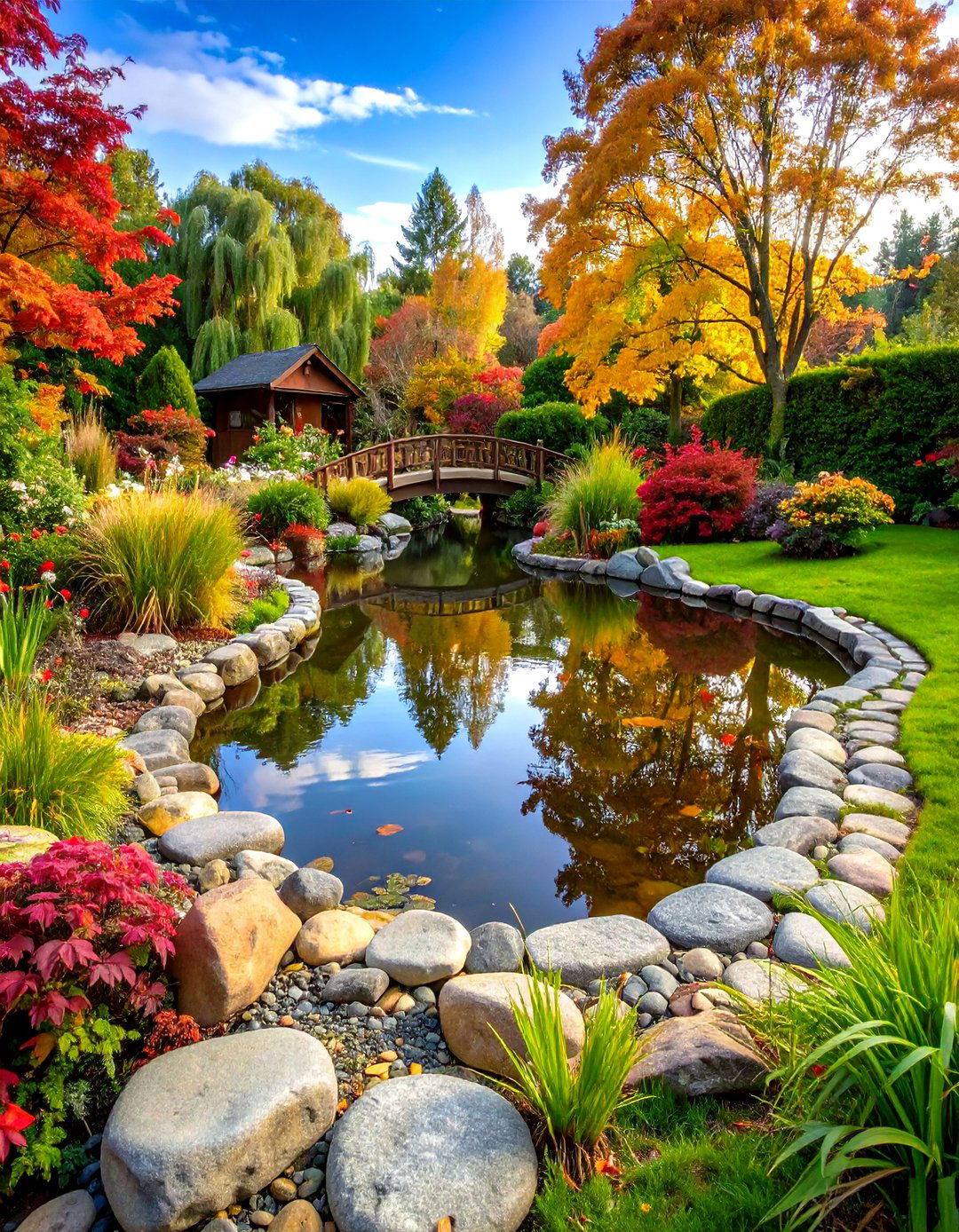
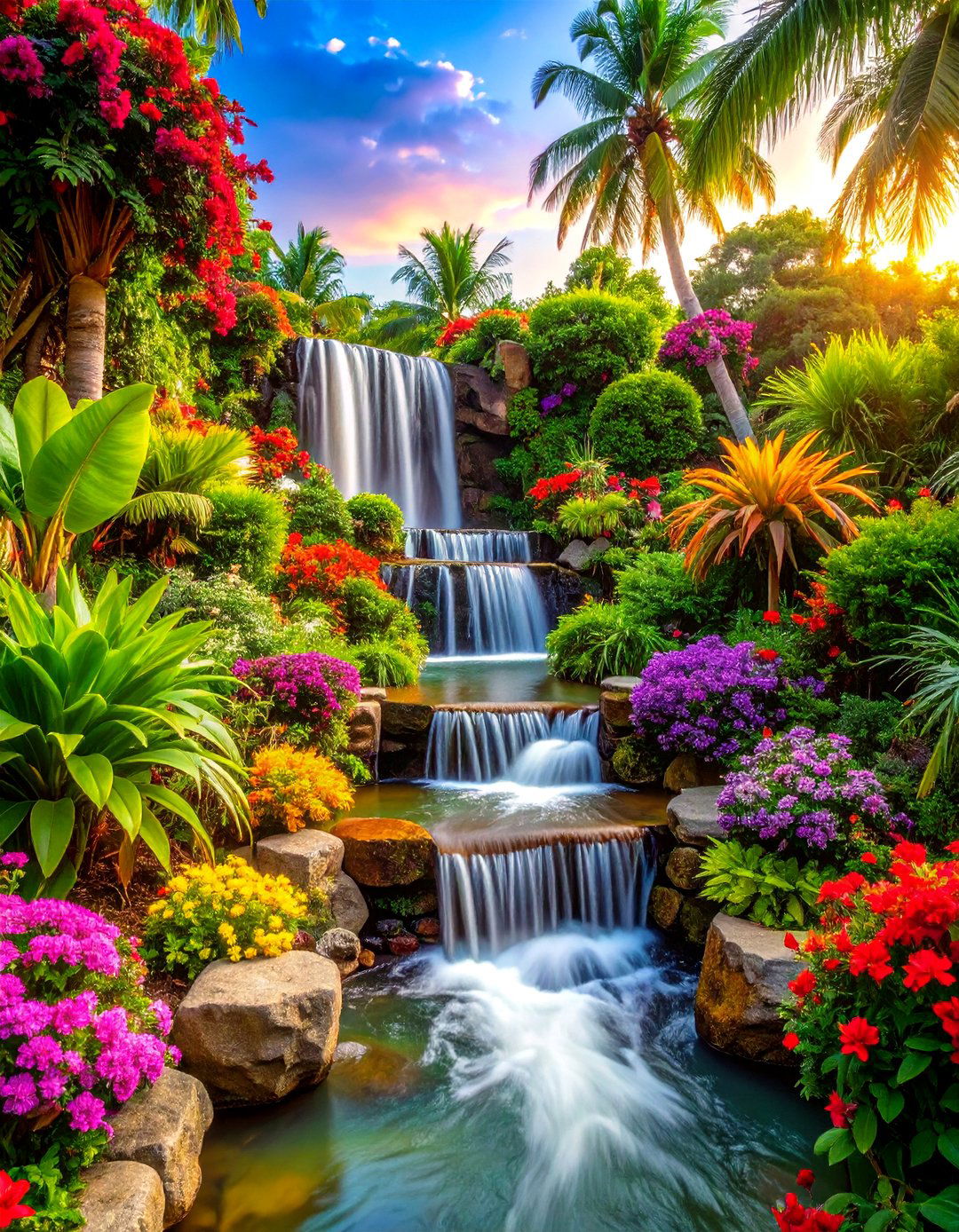
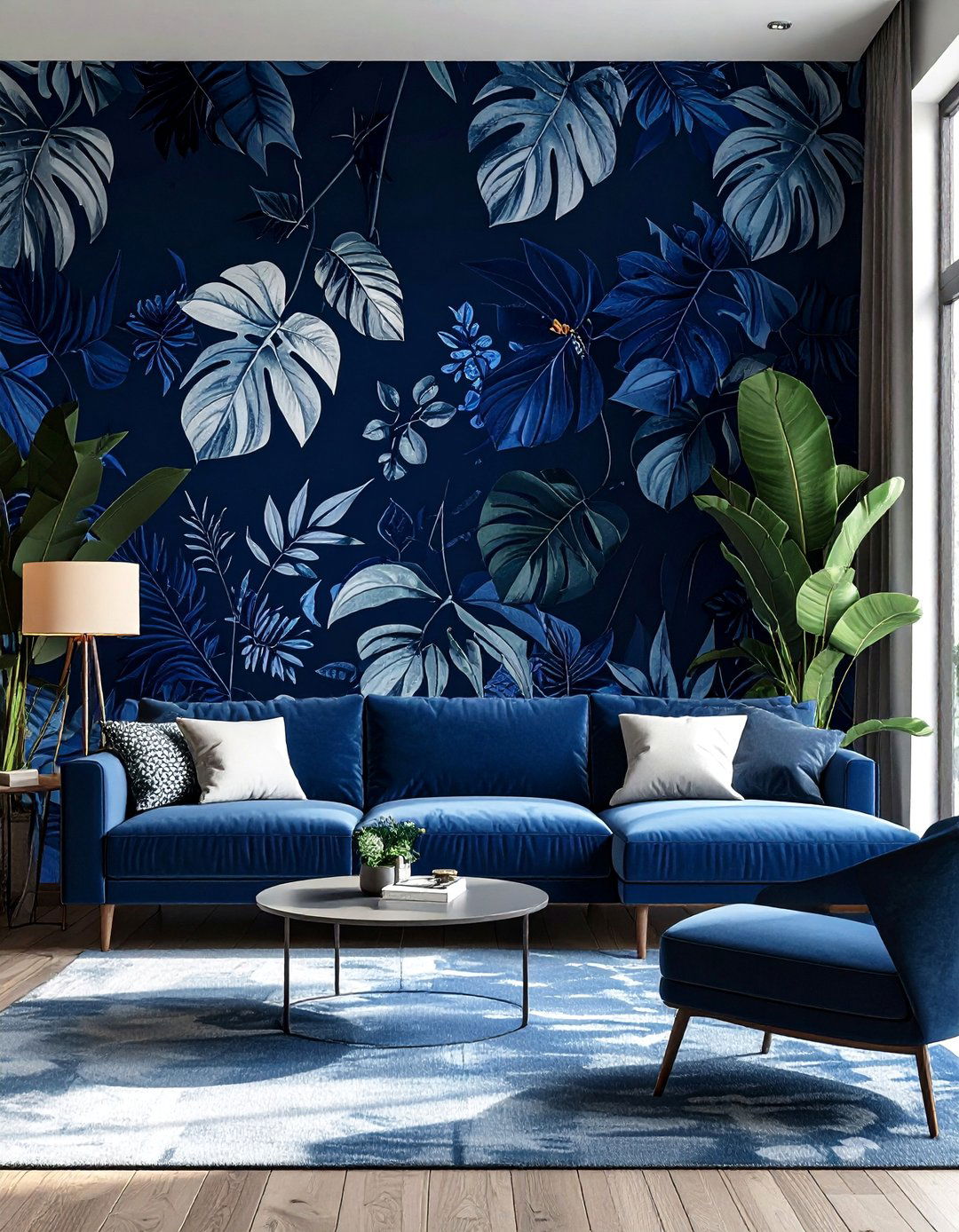
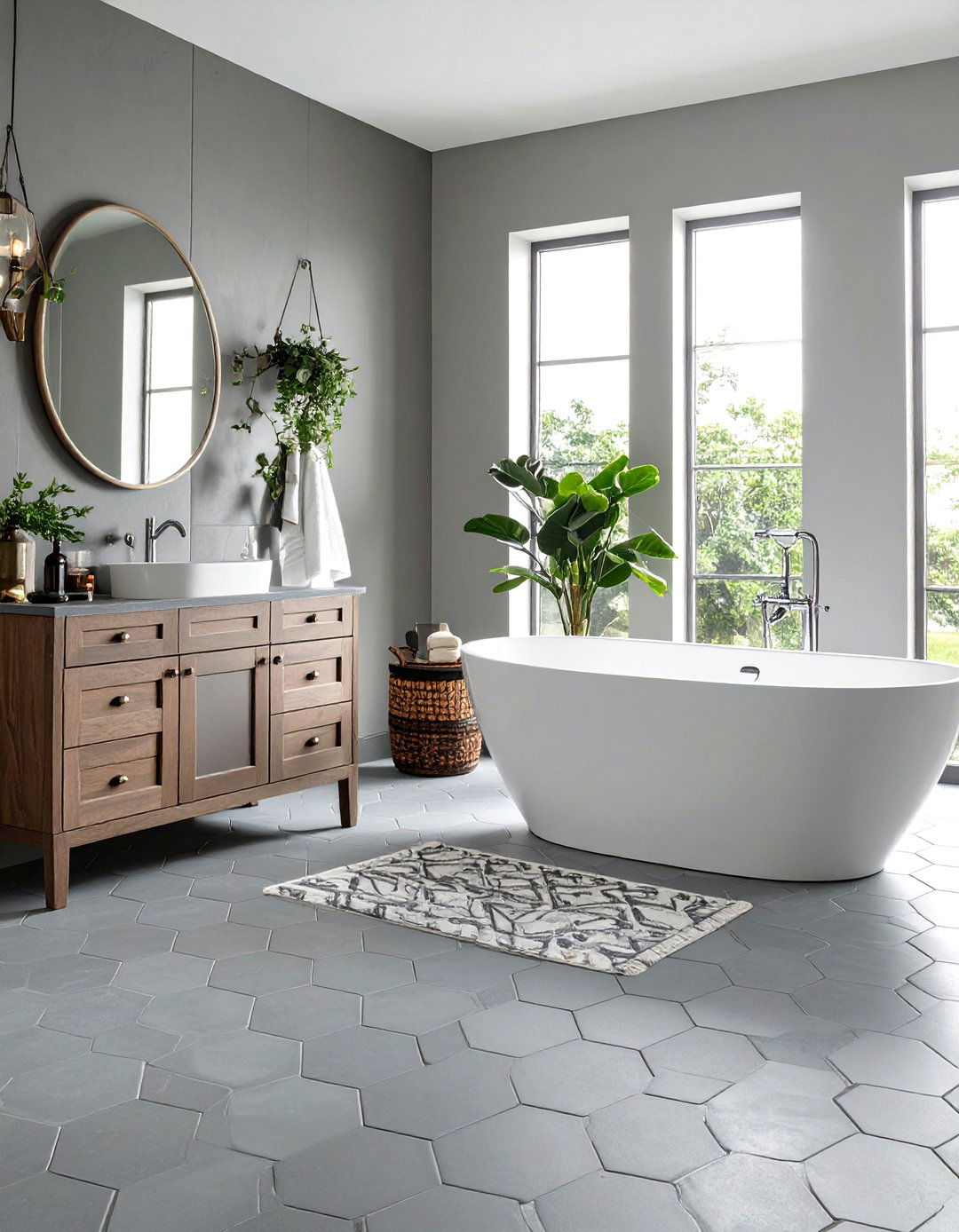
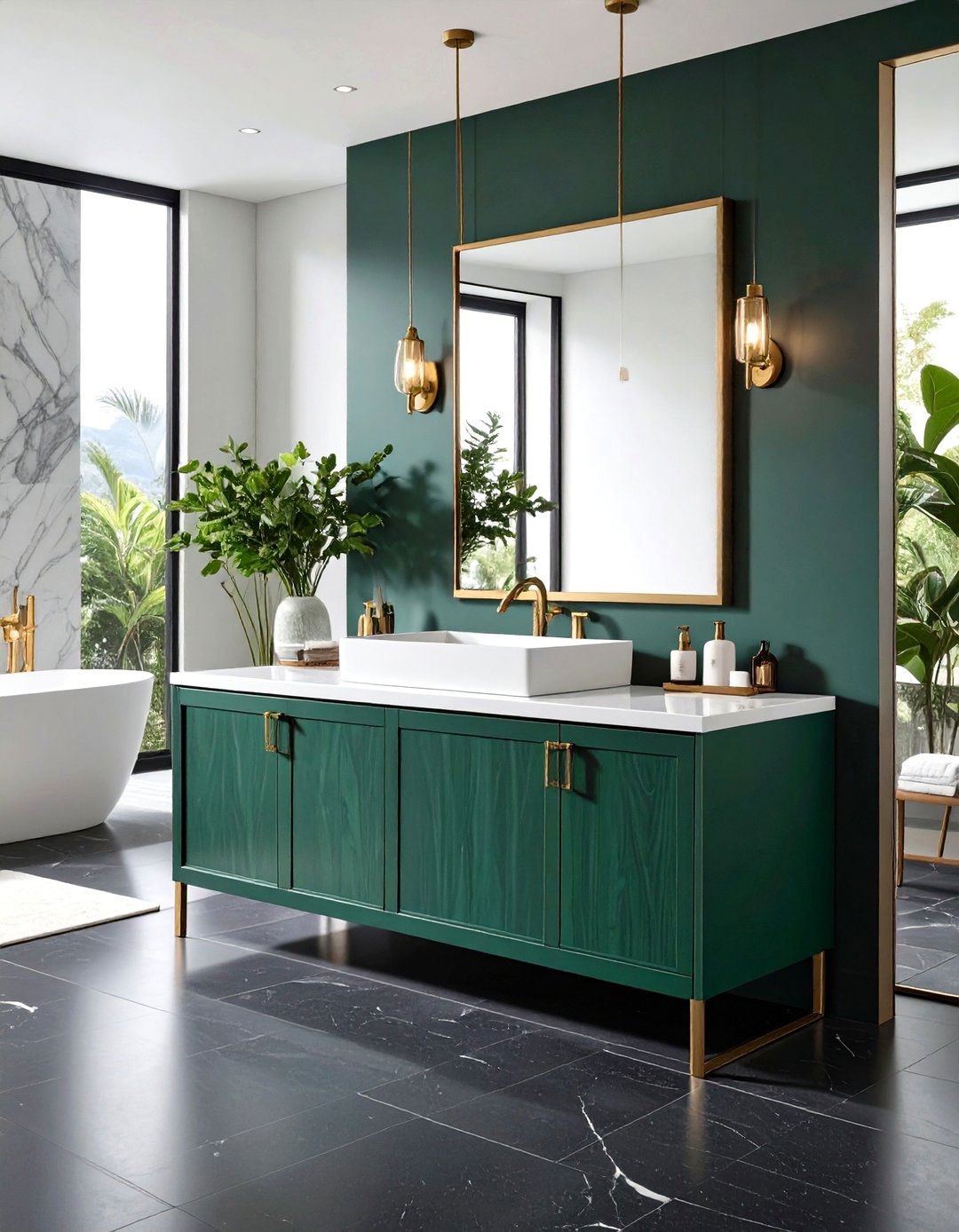
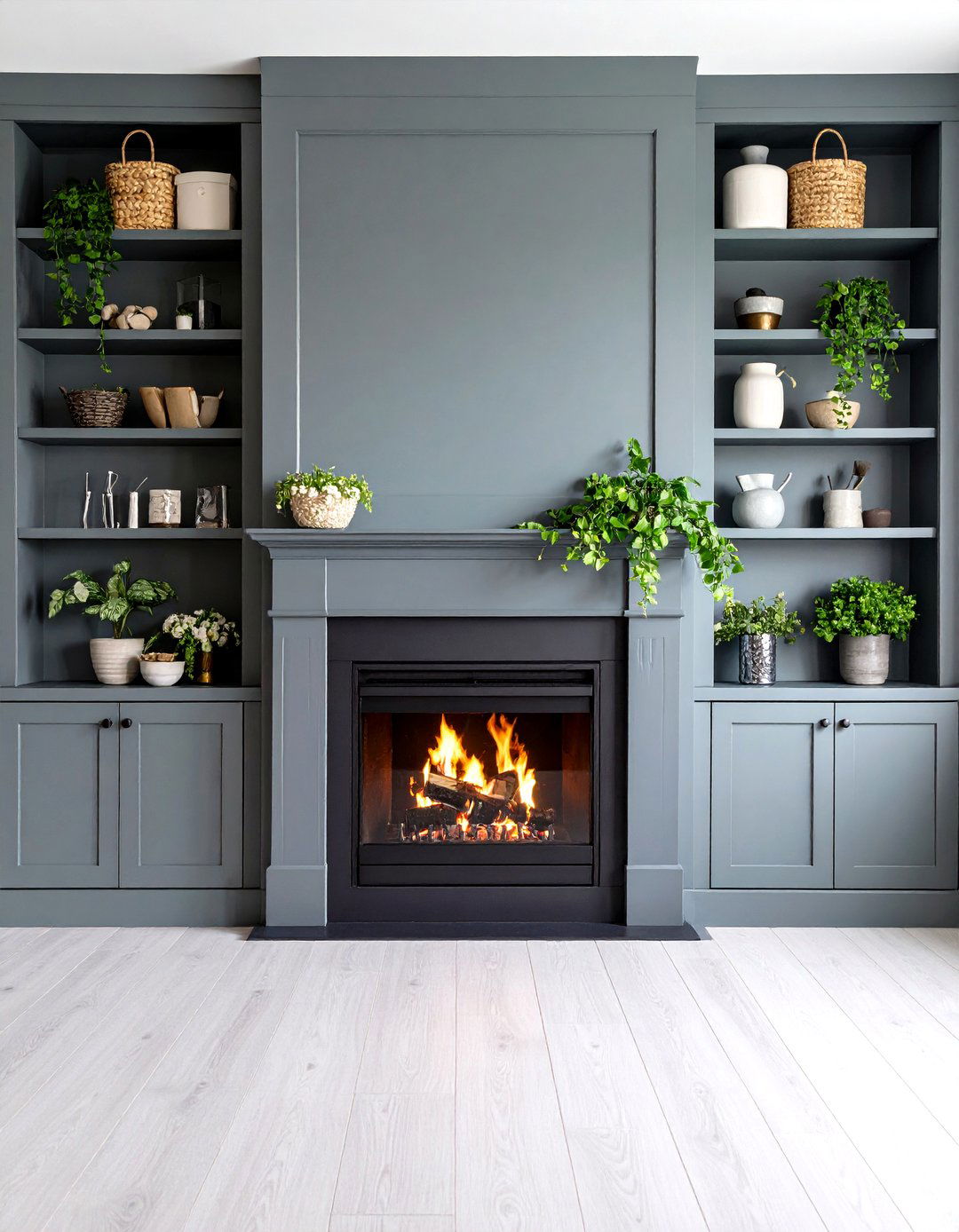
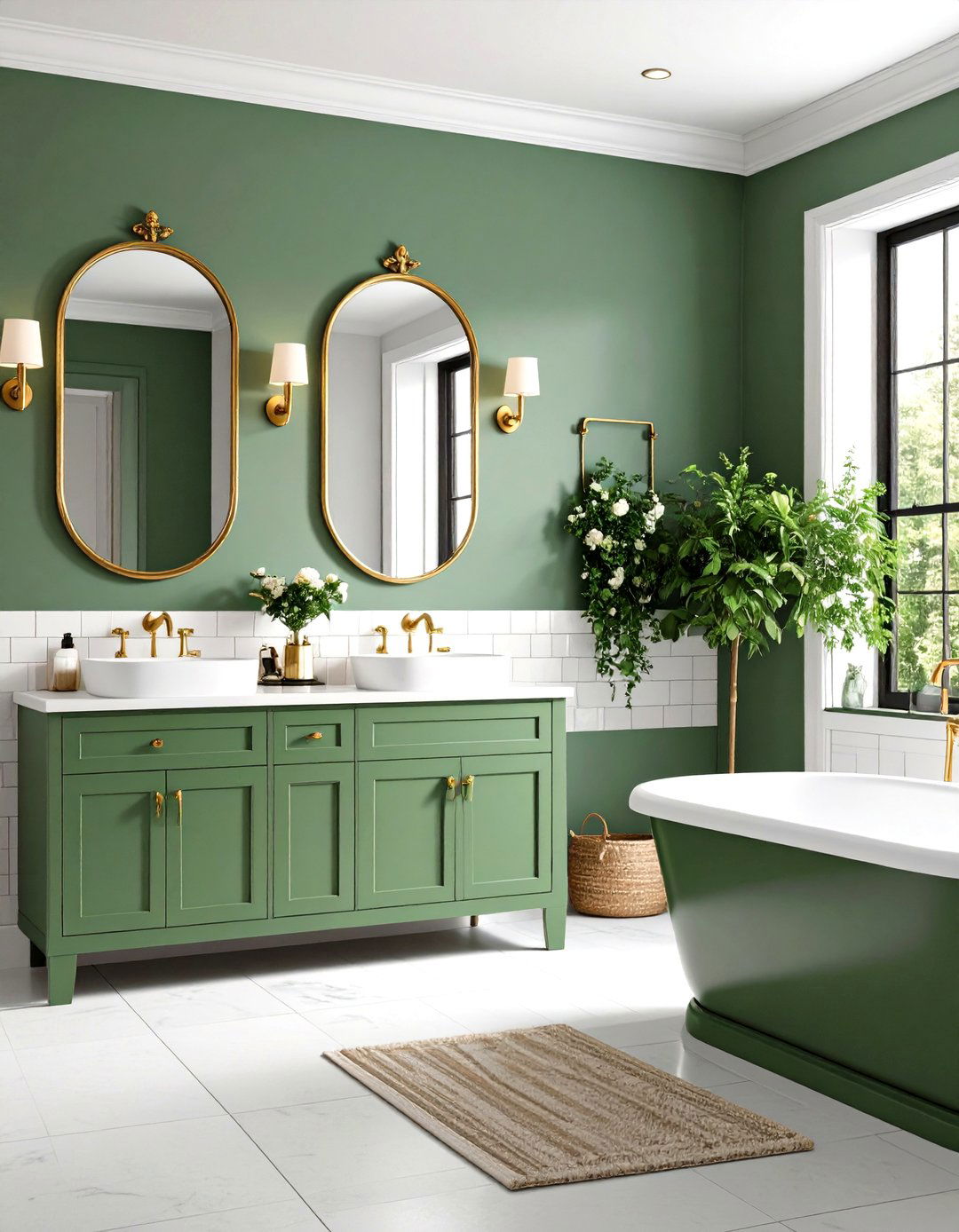
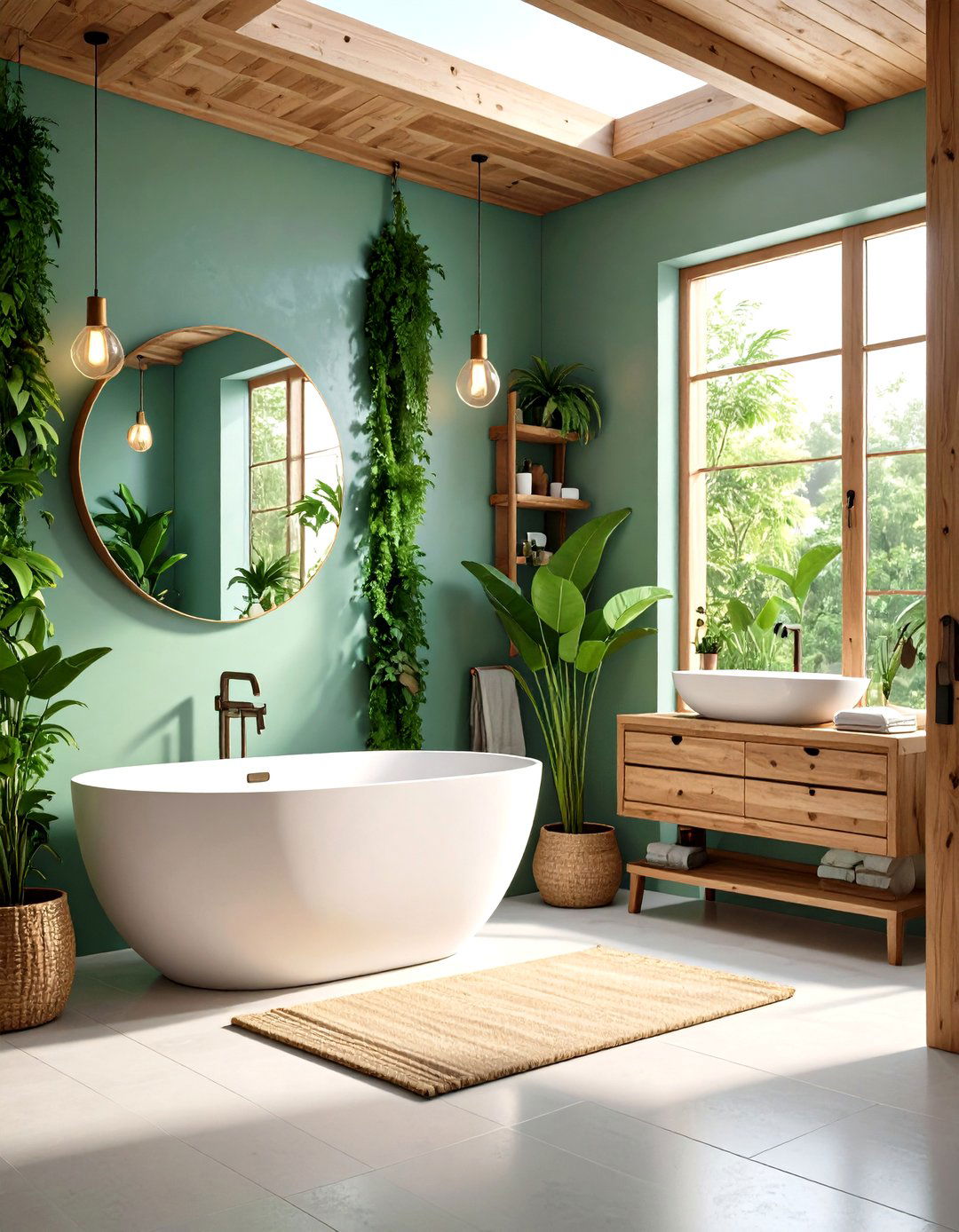
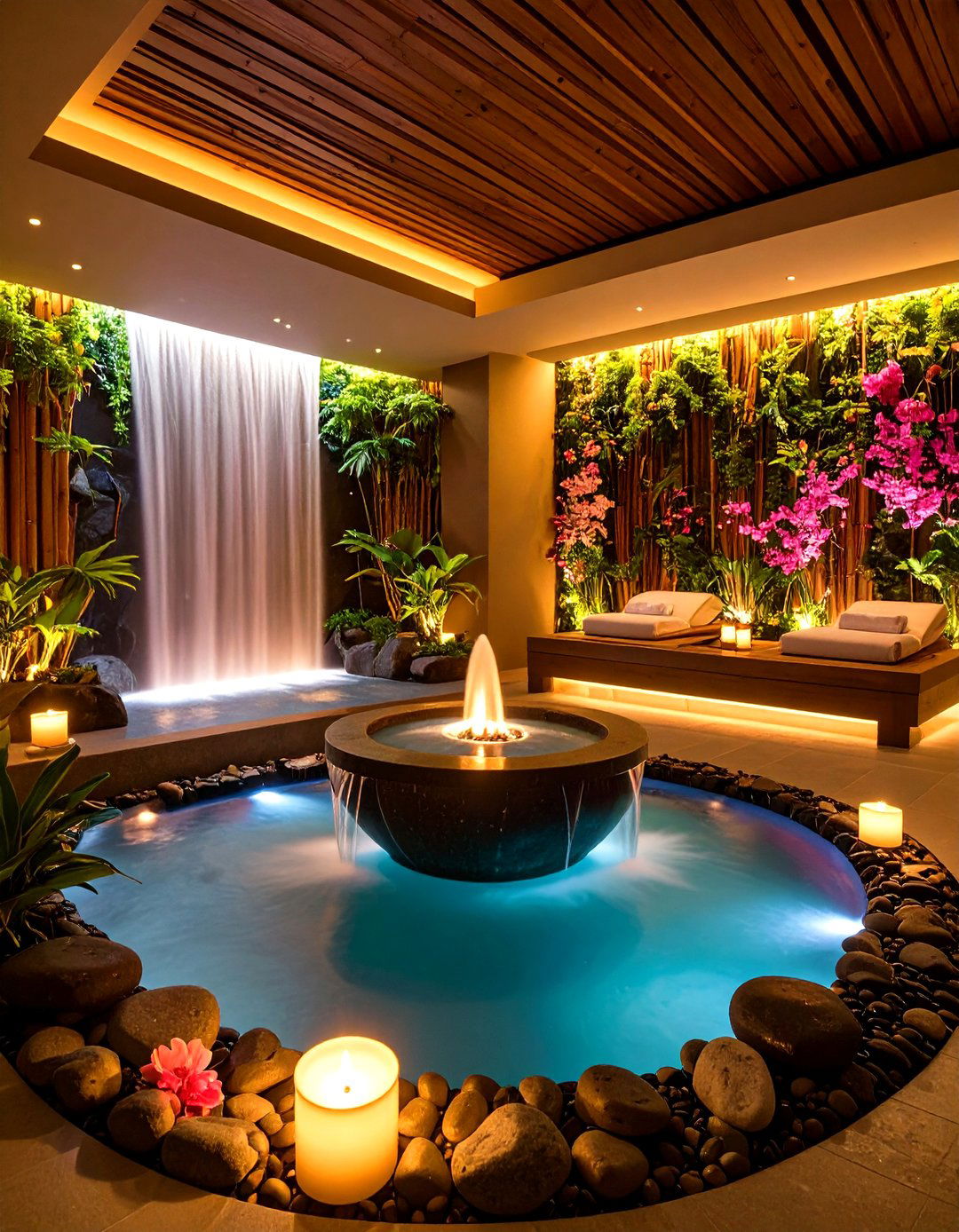
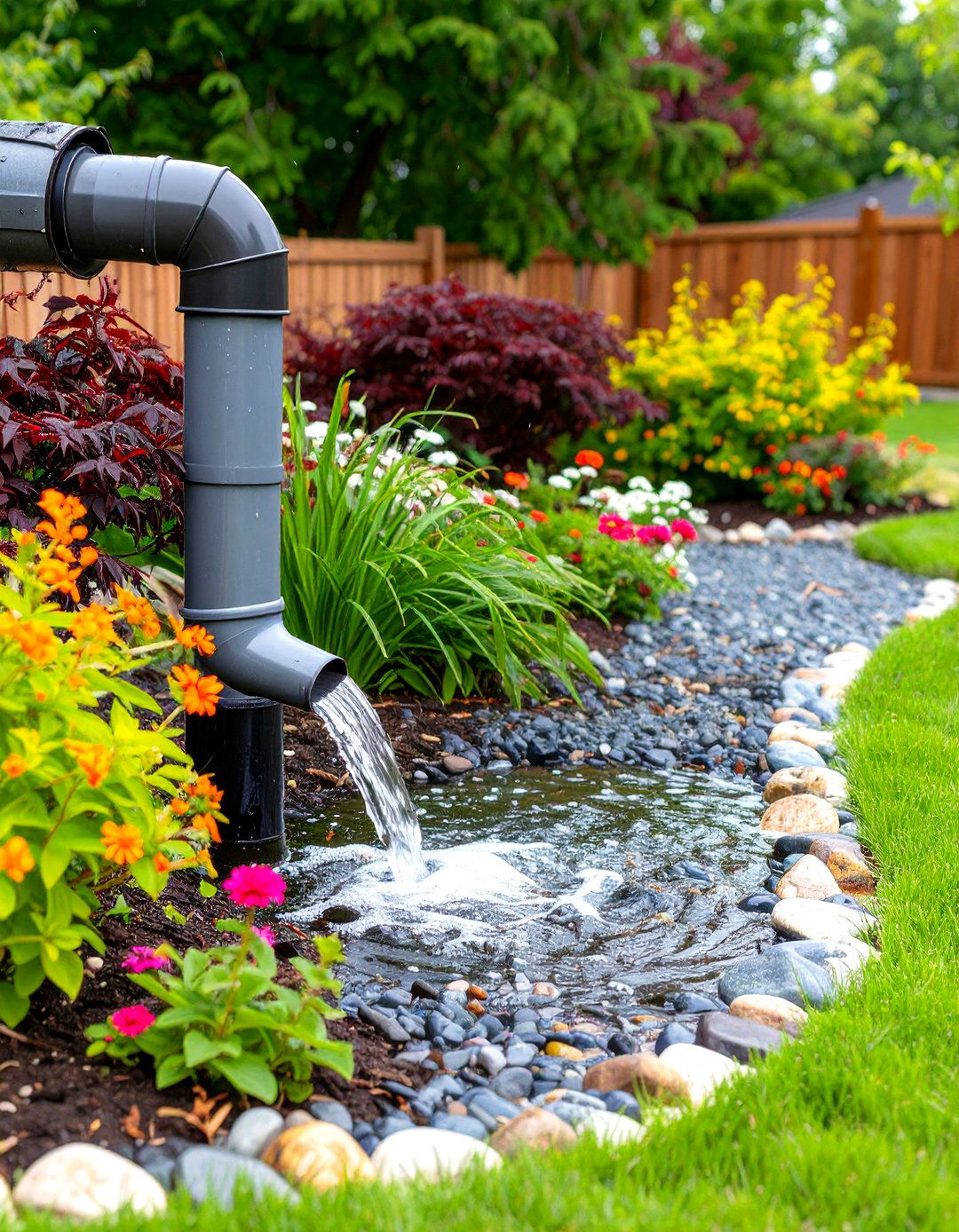
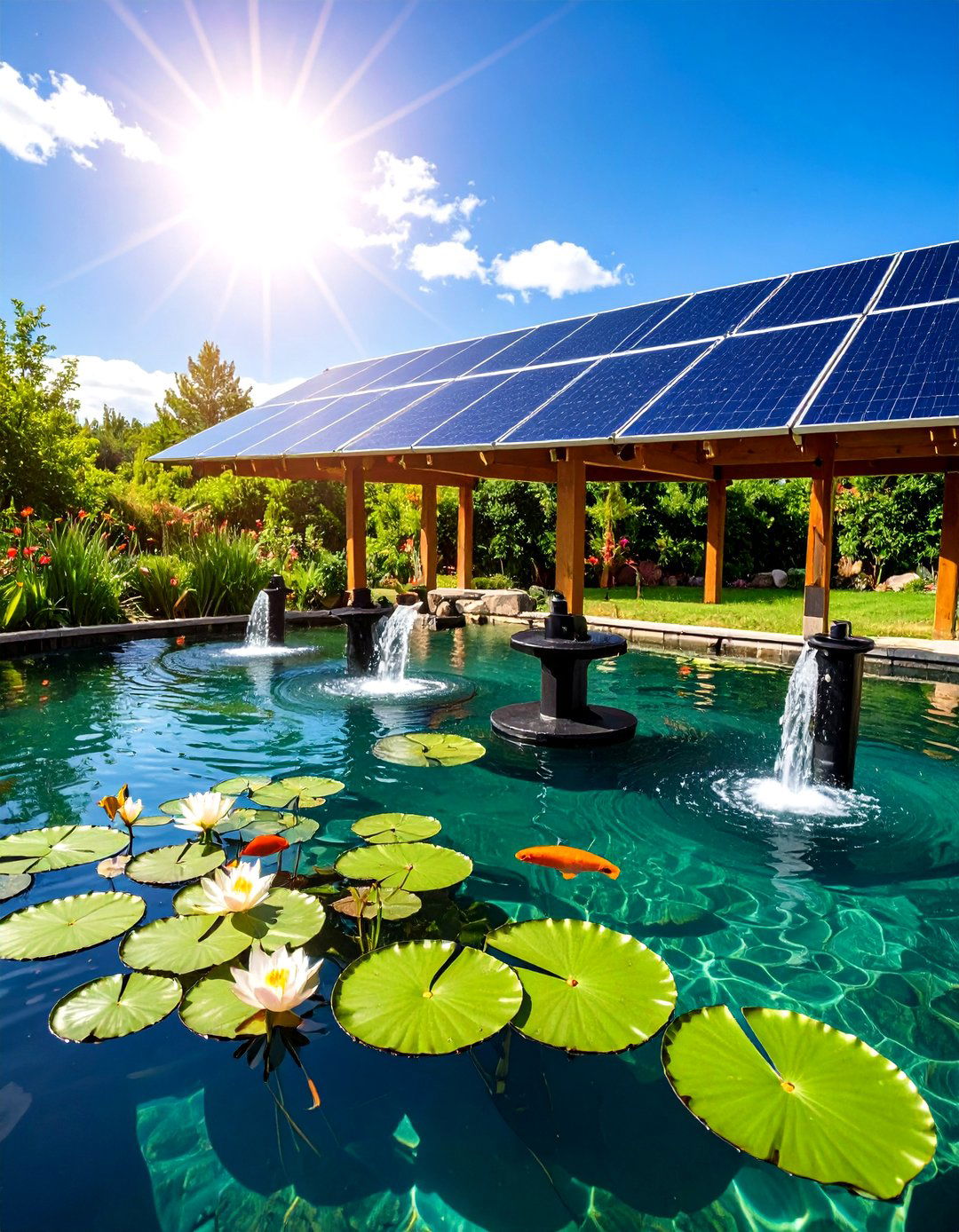
Leave a Reply